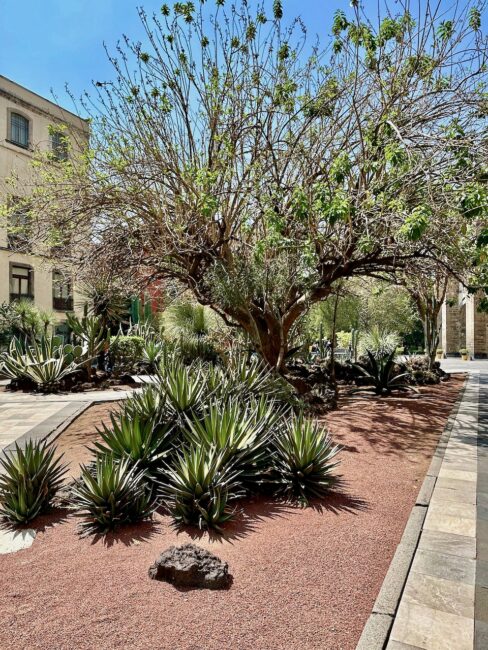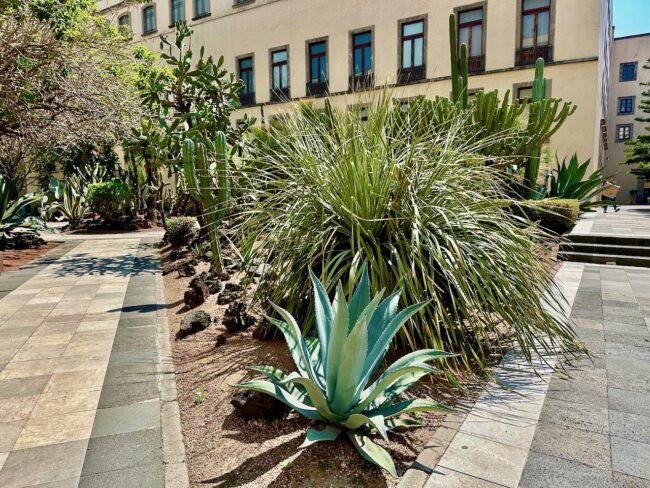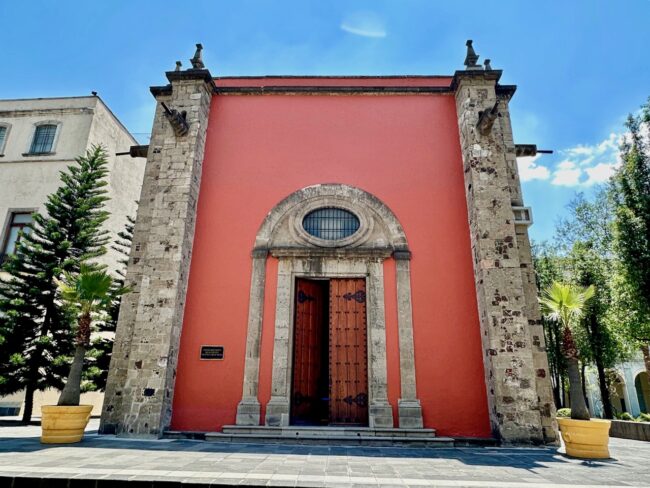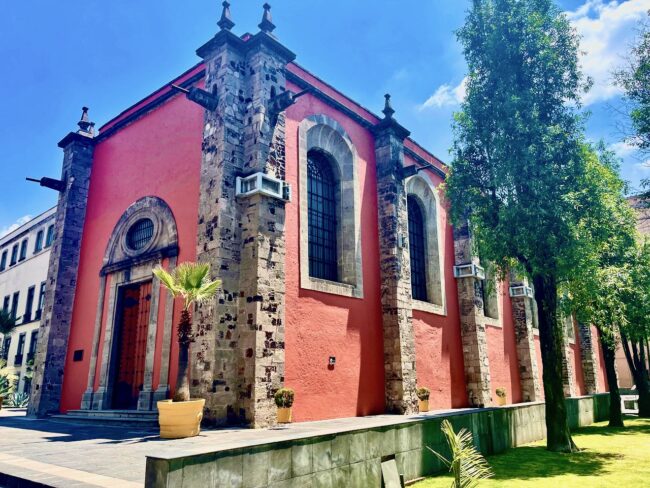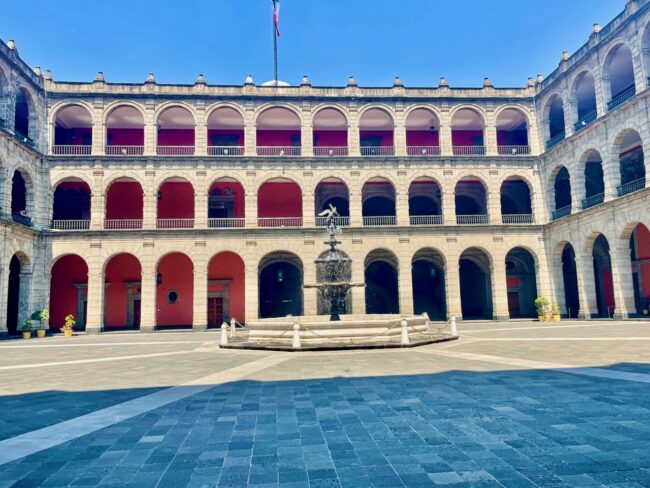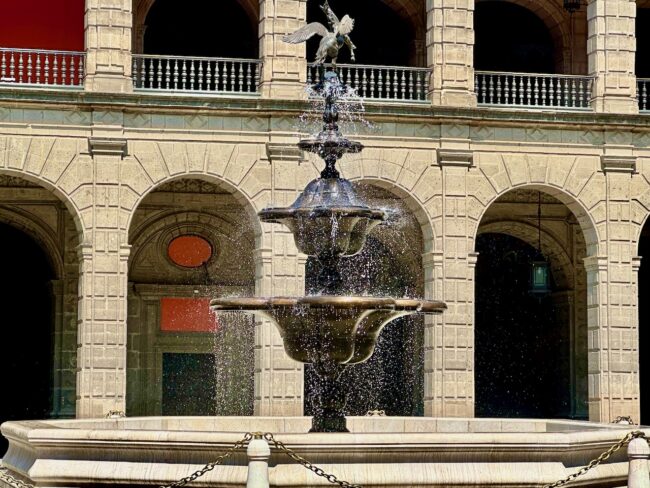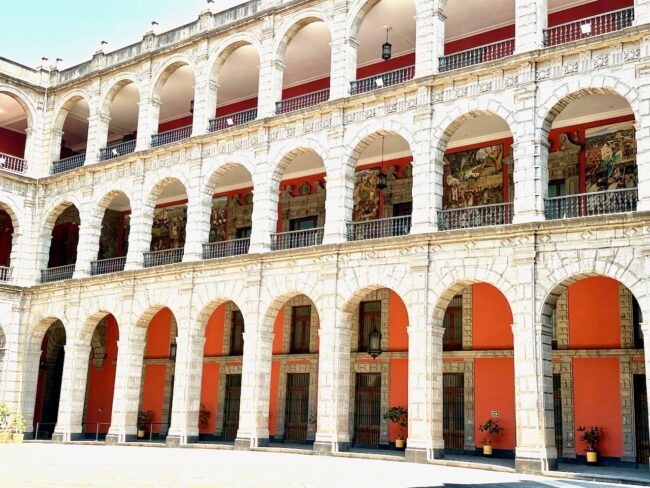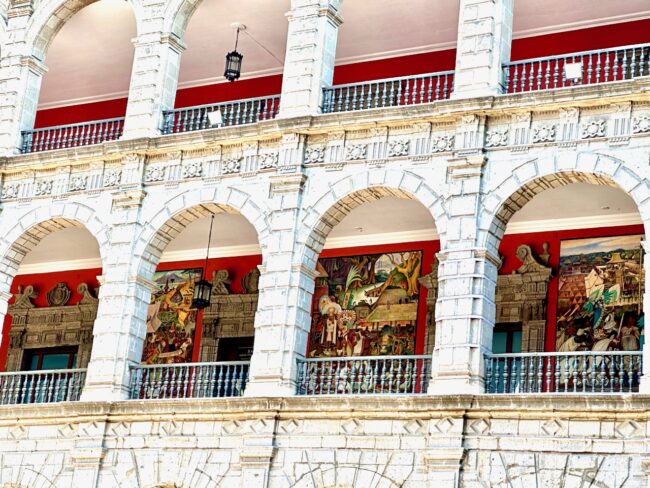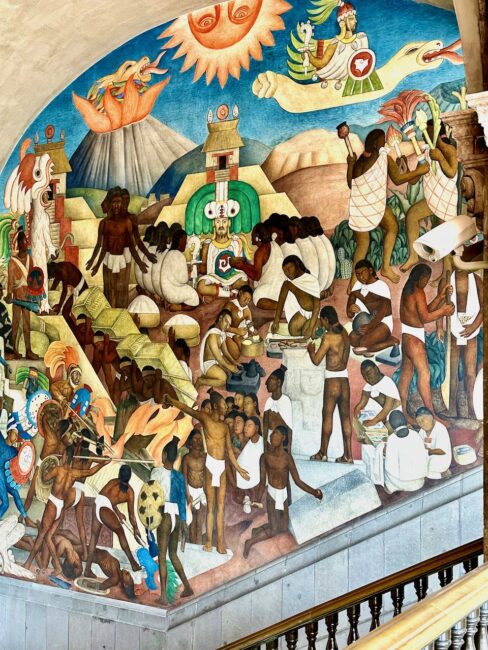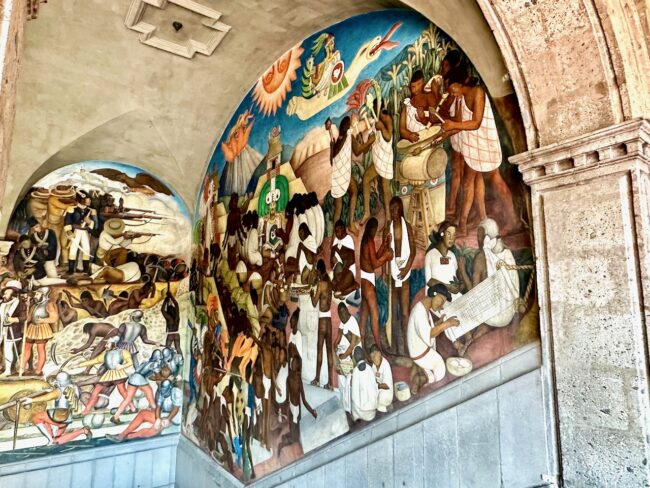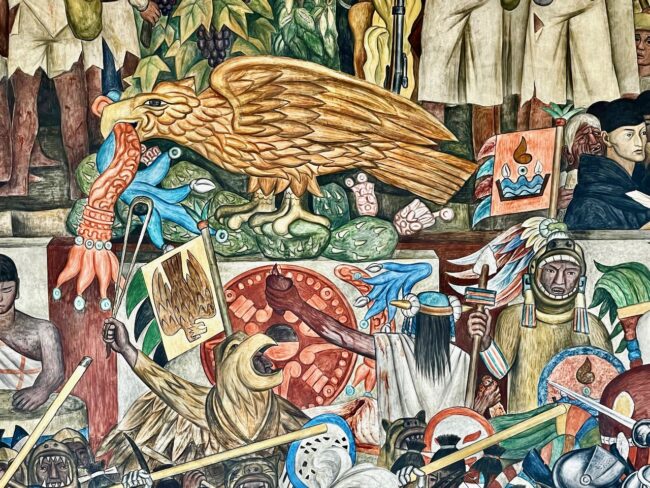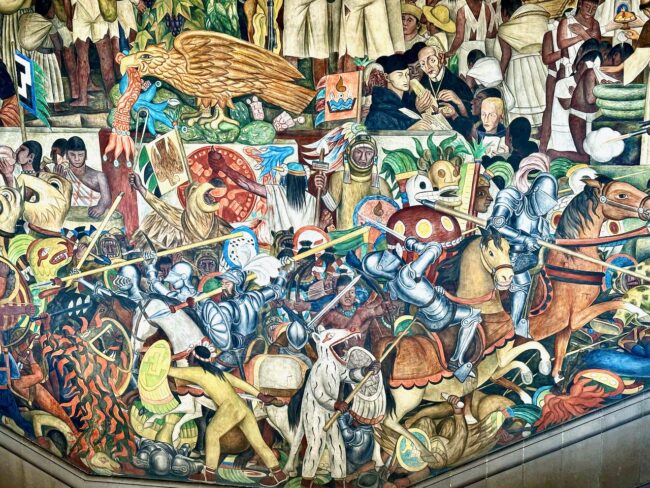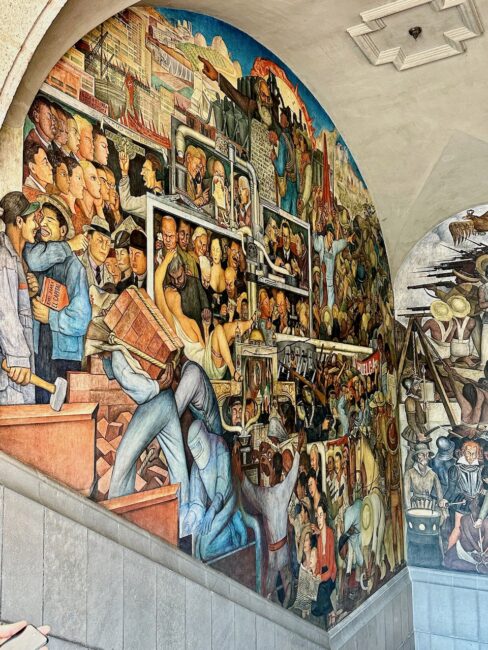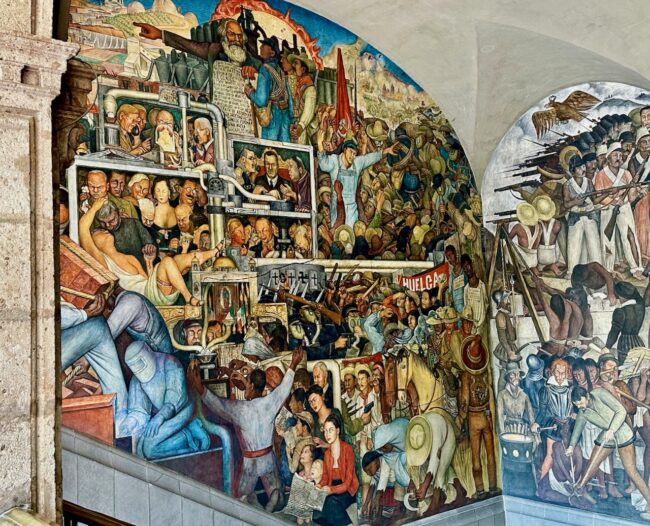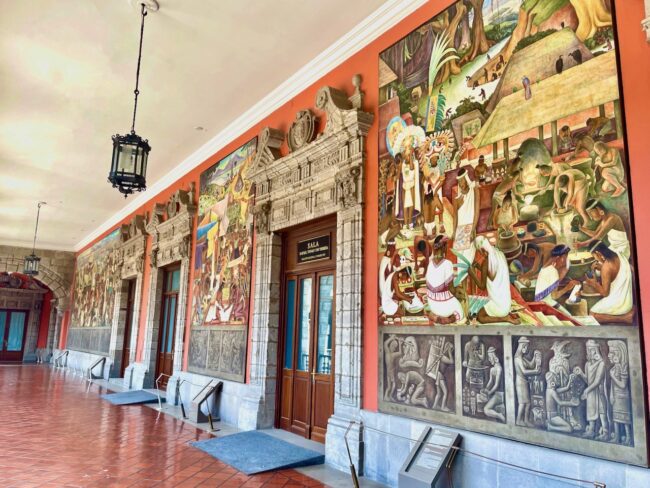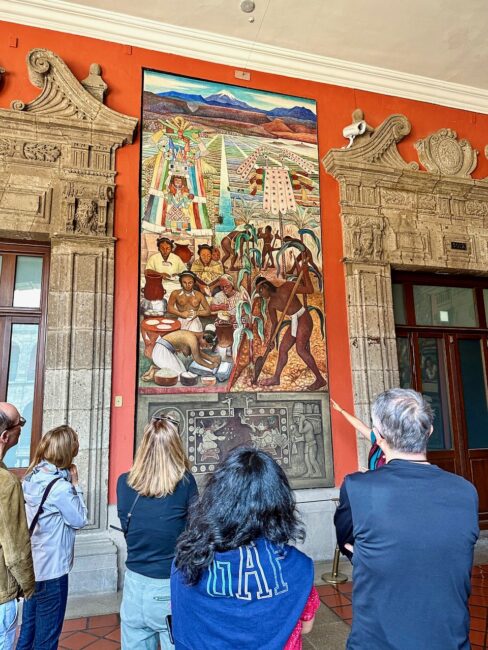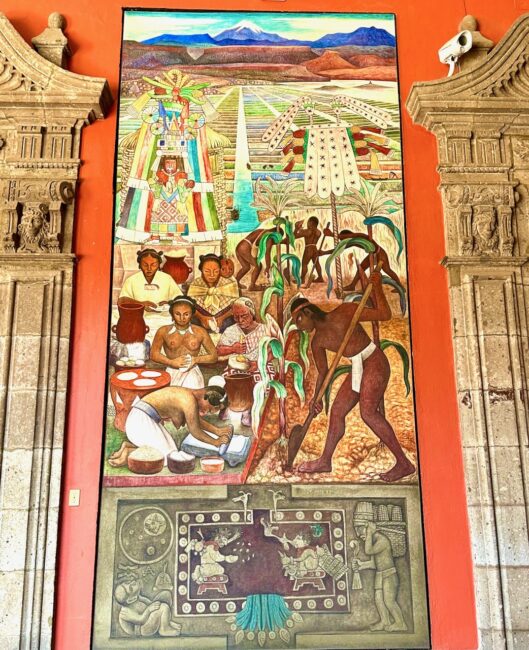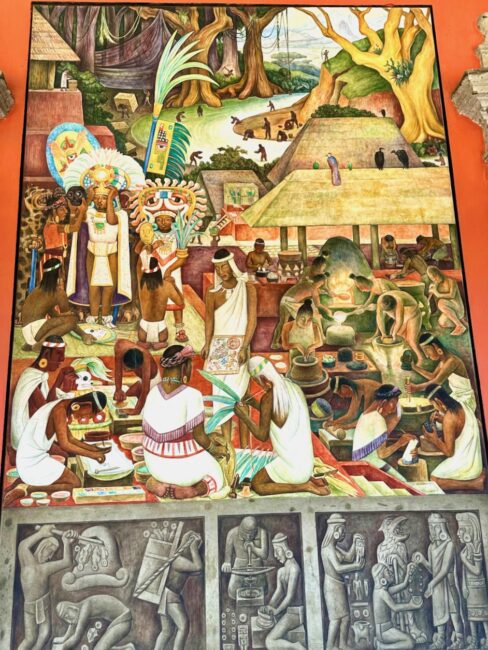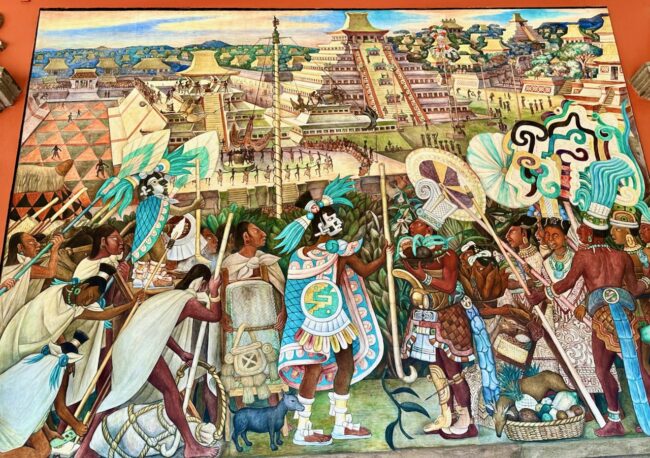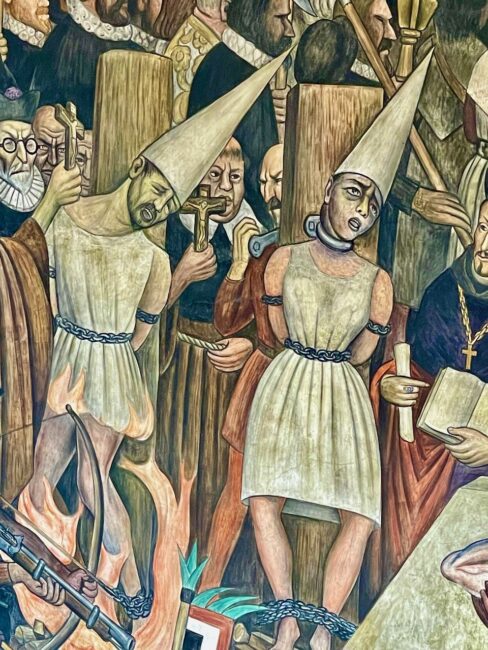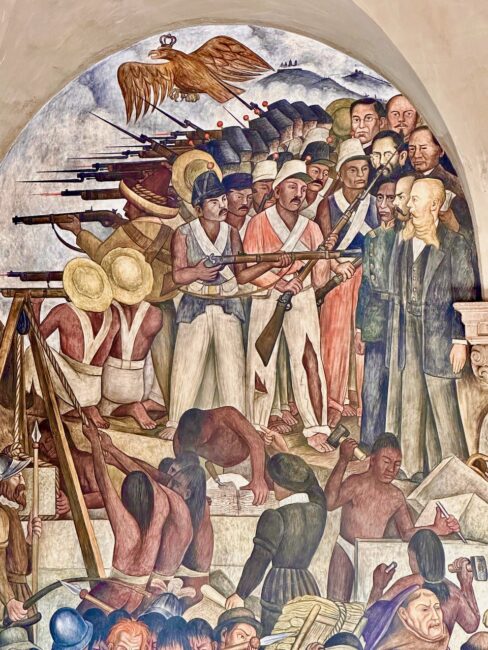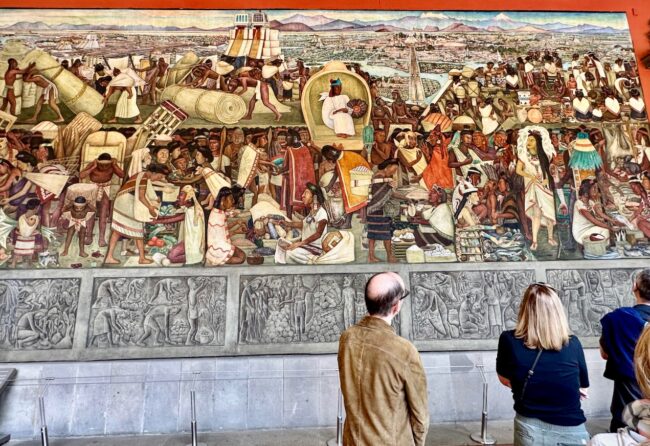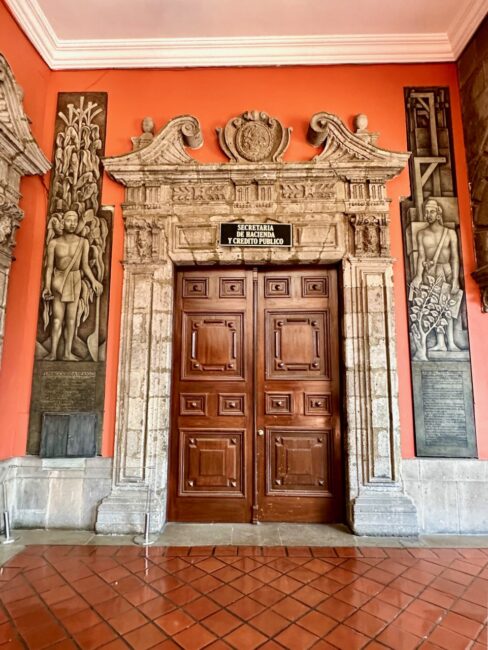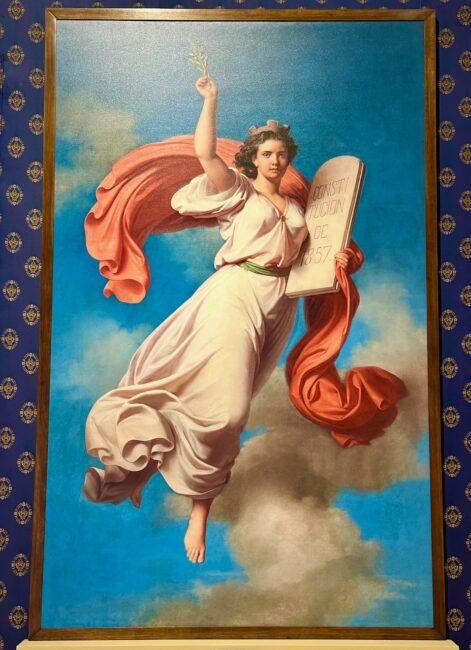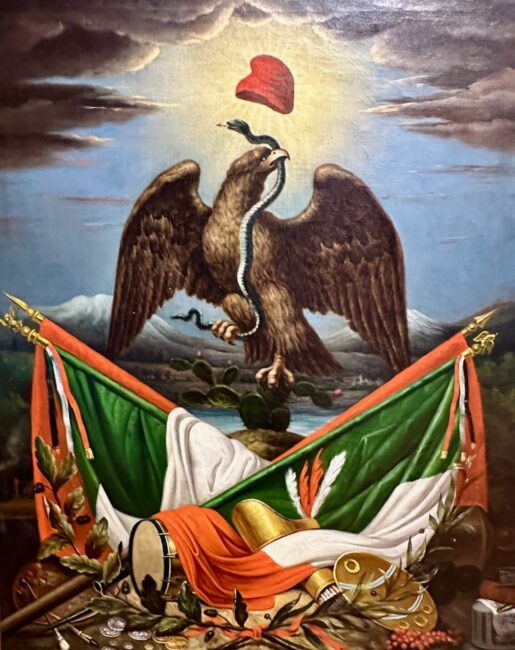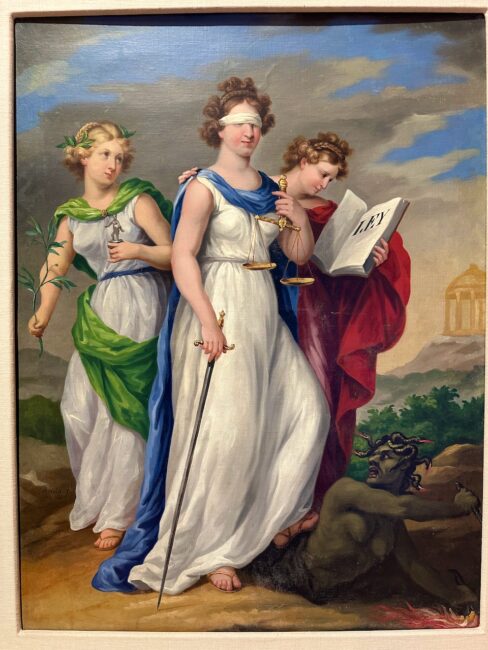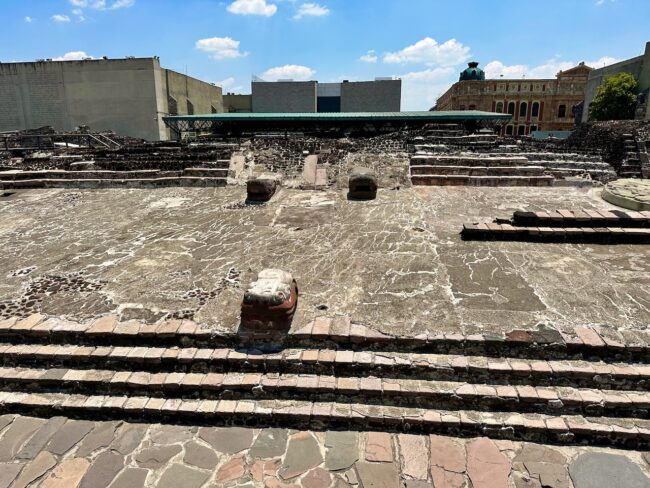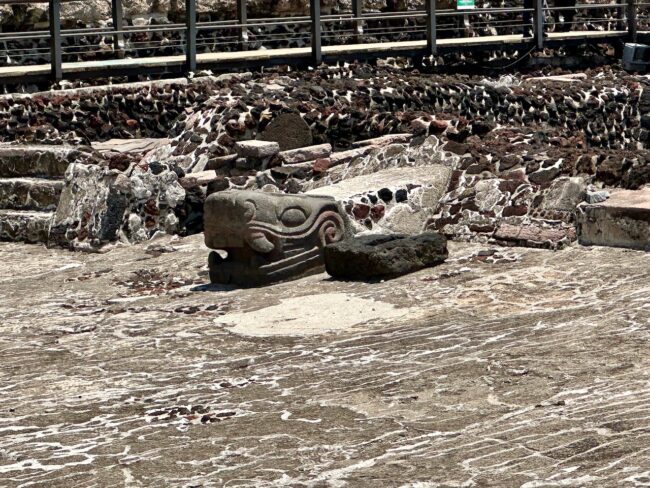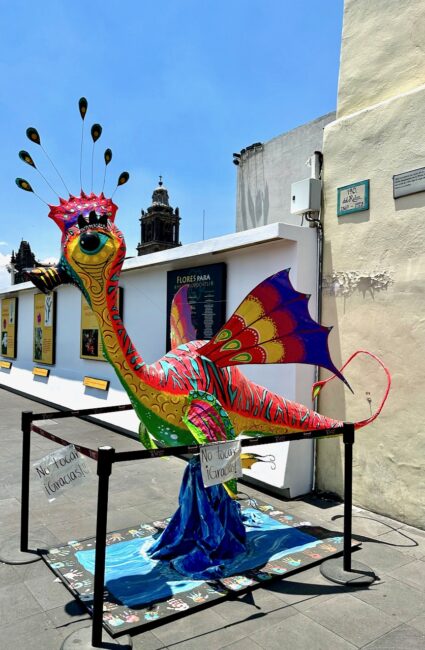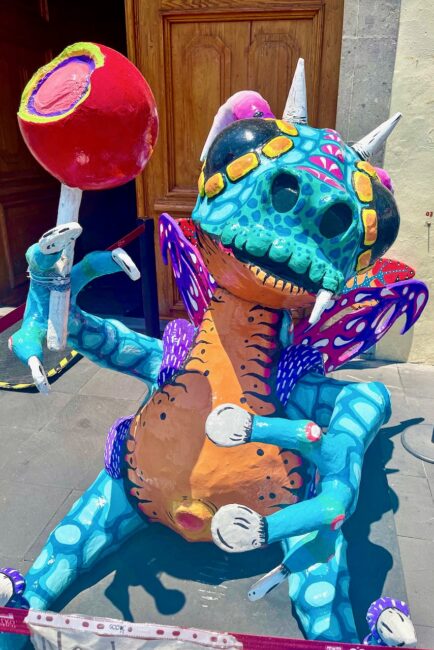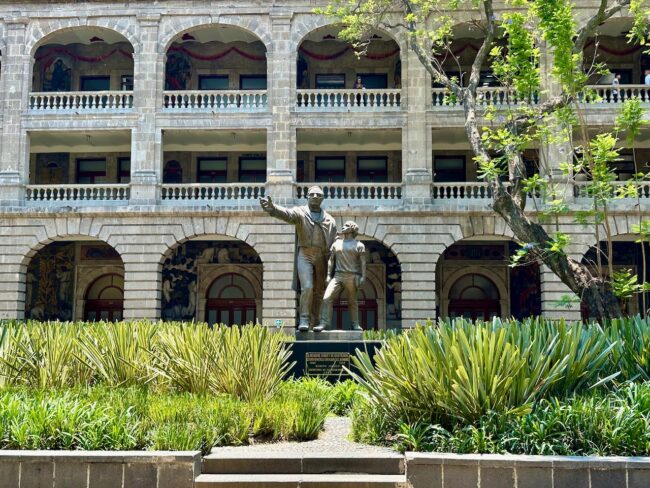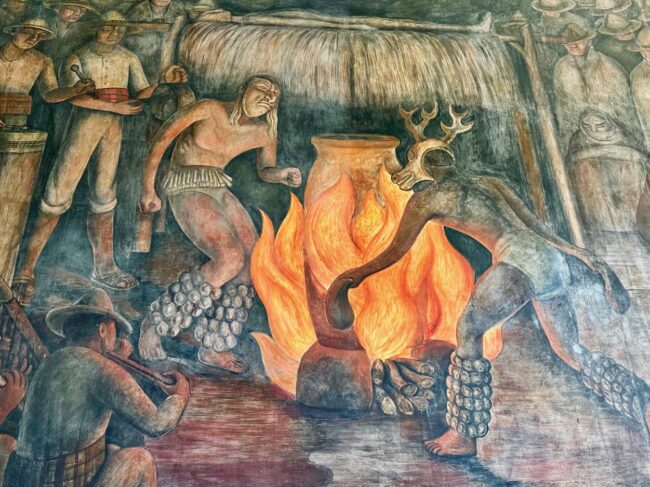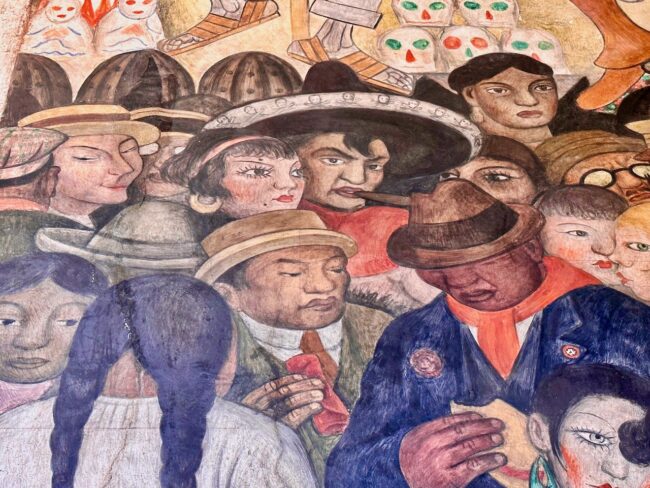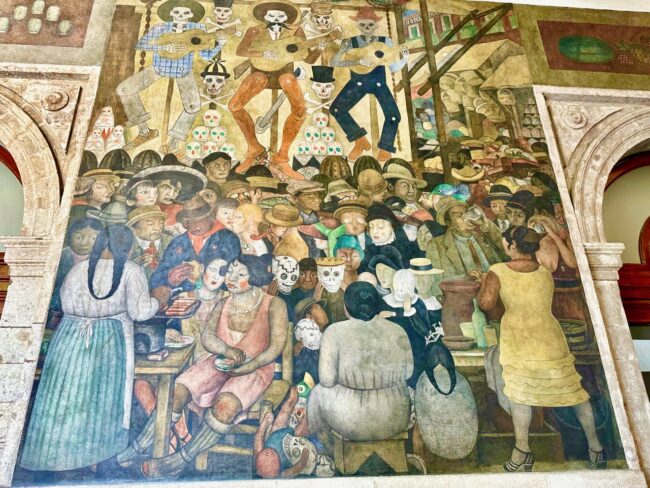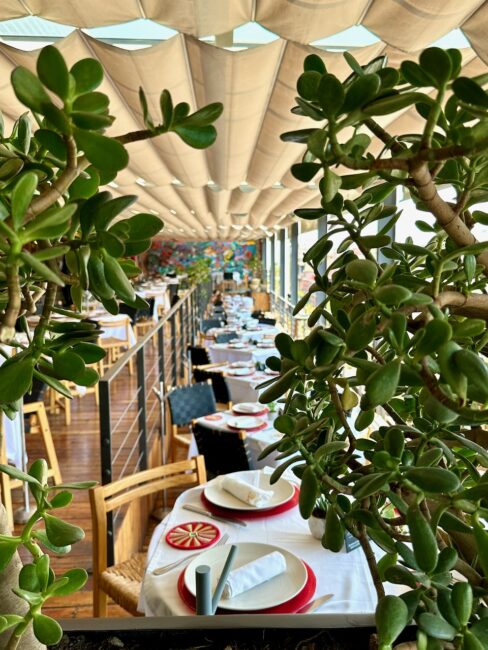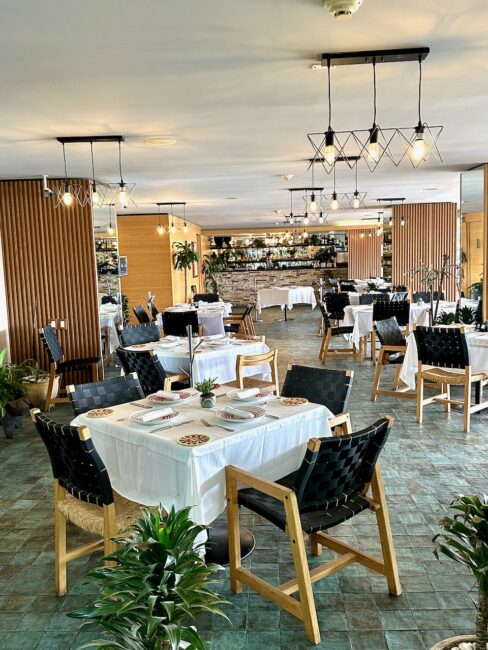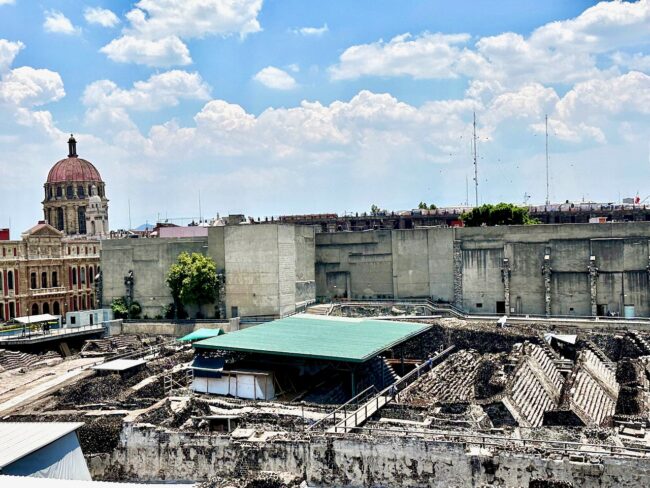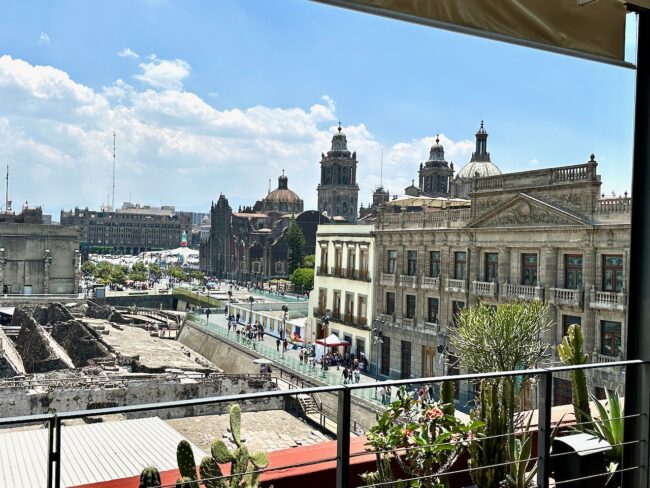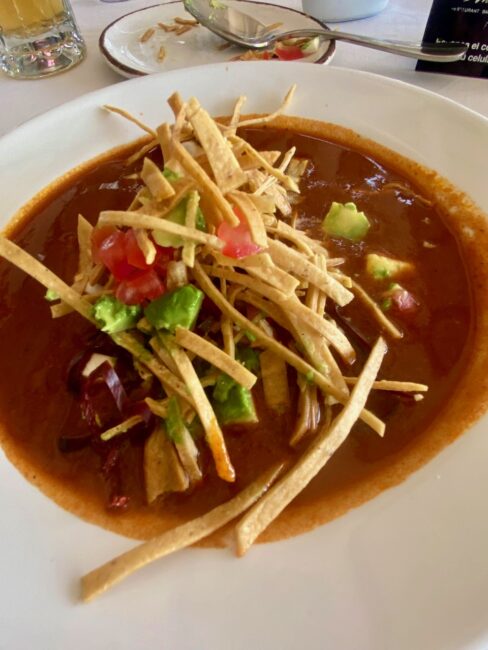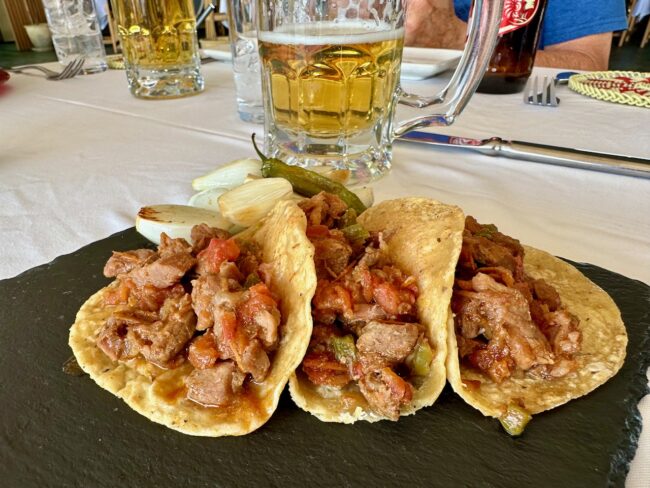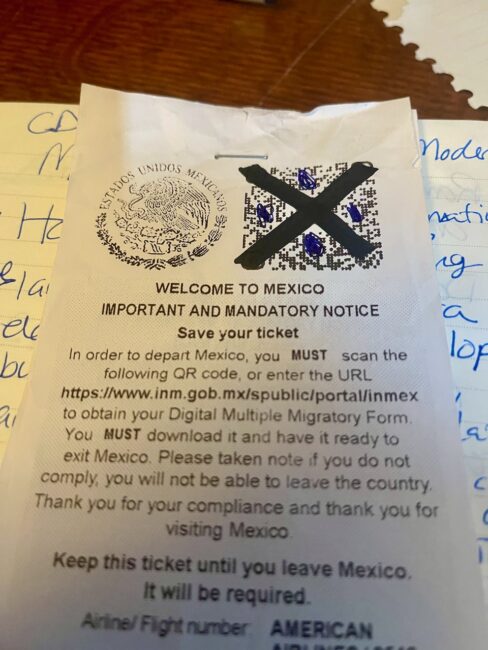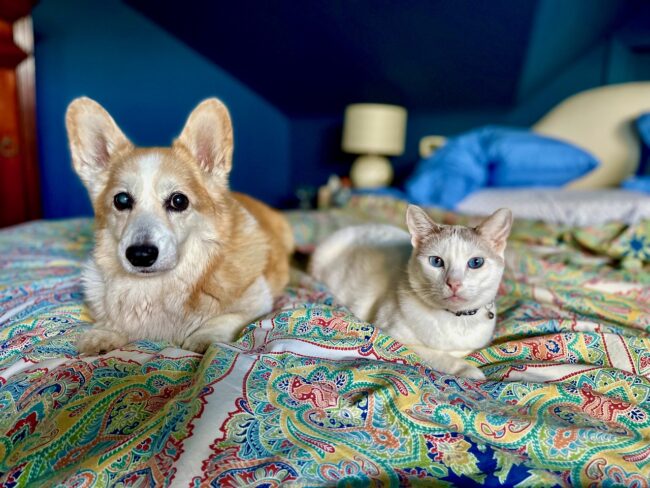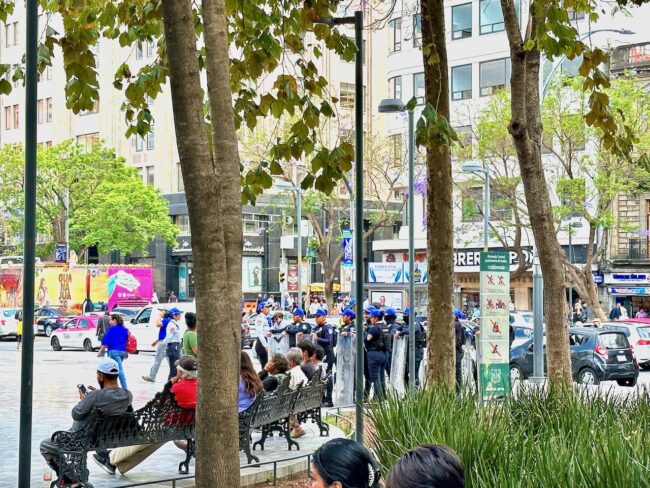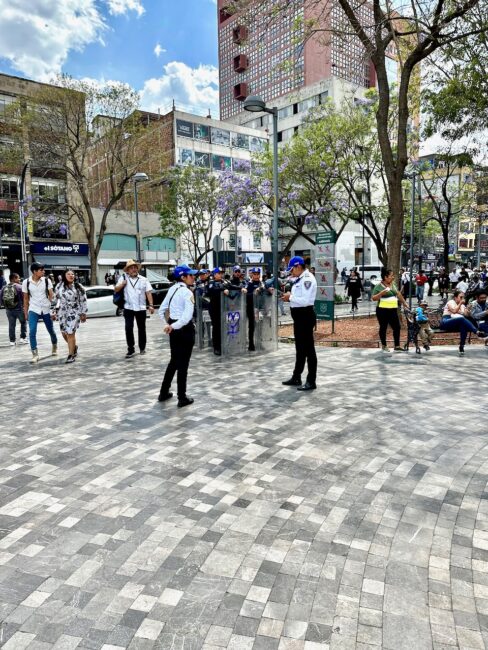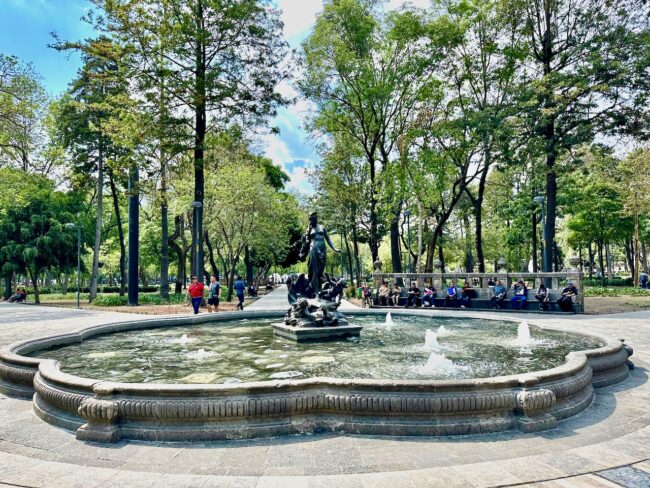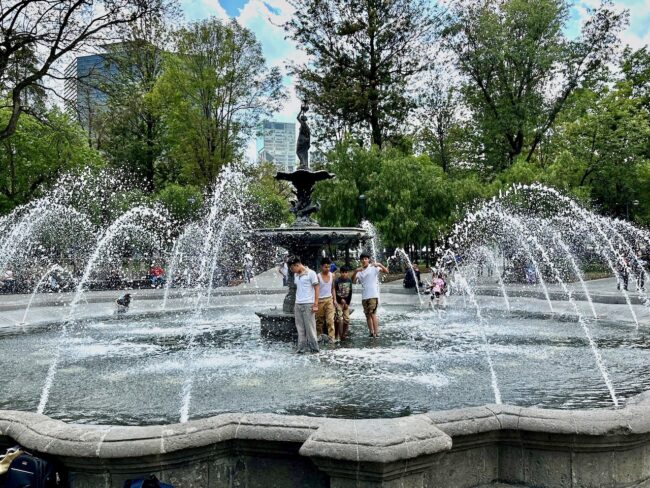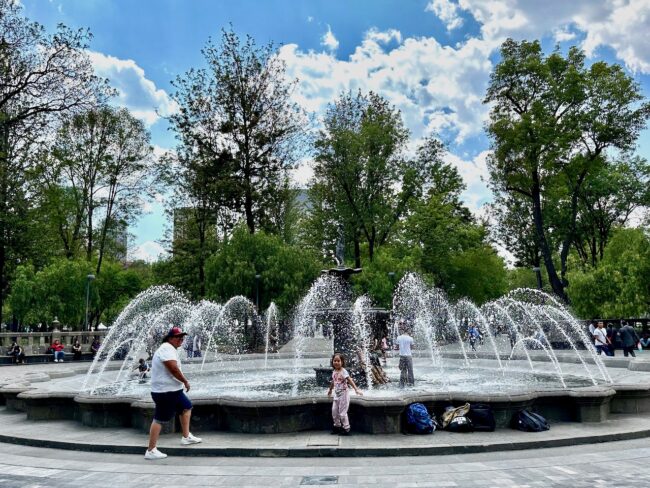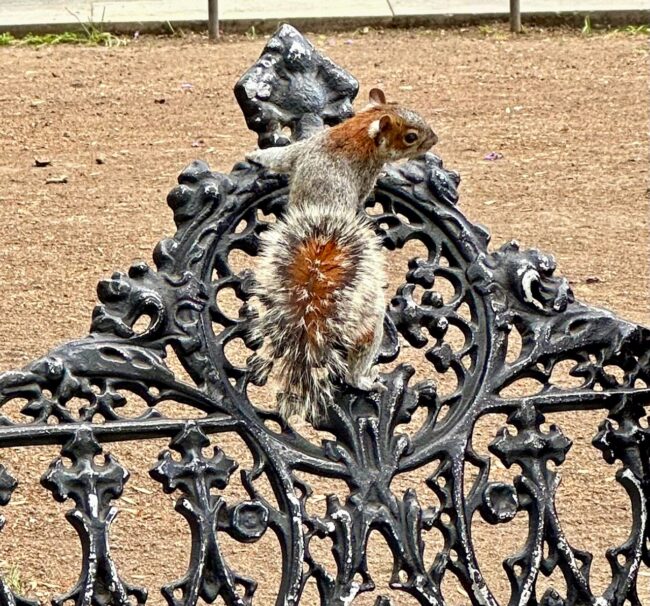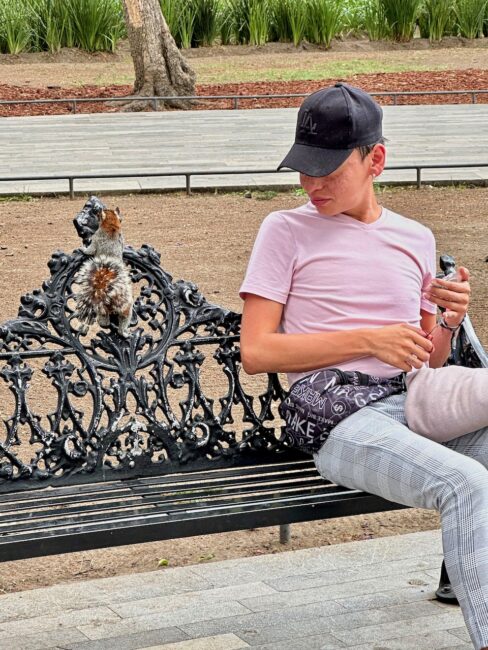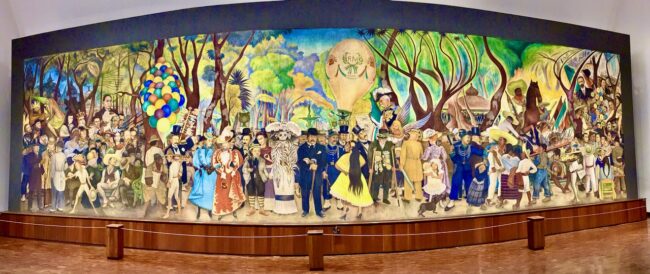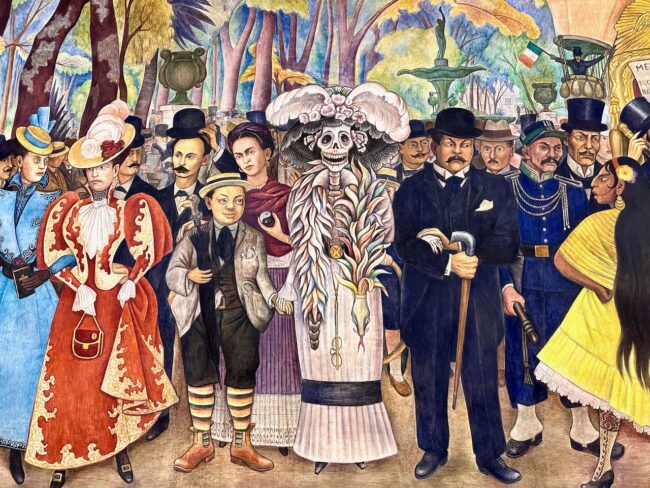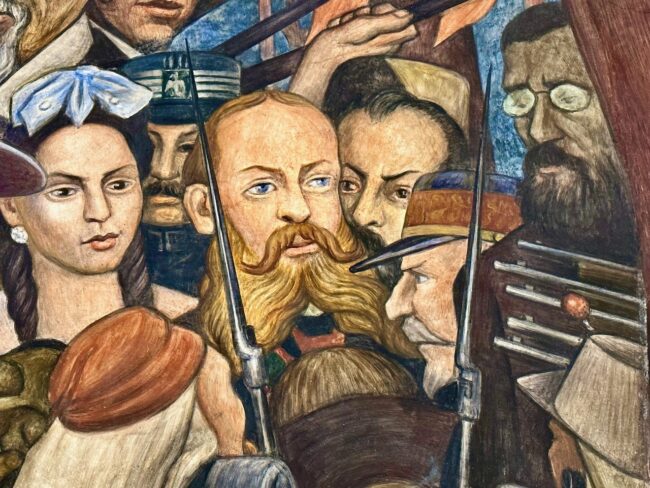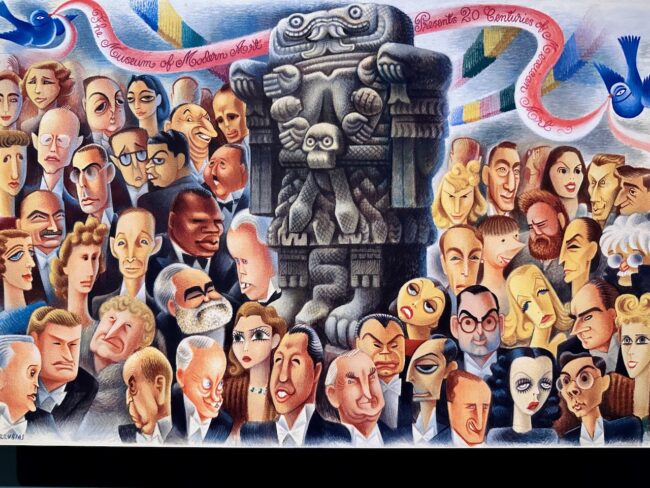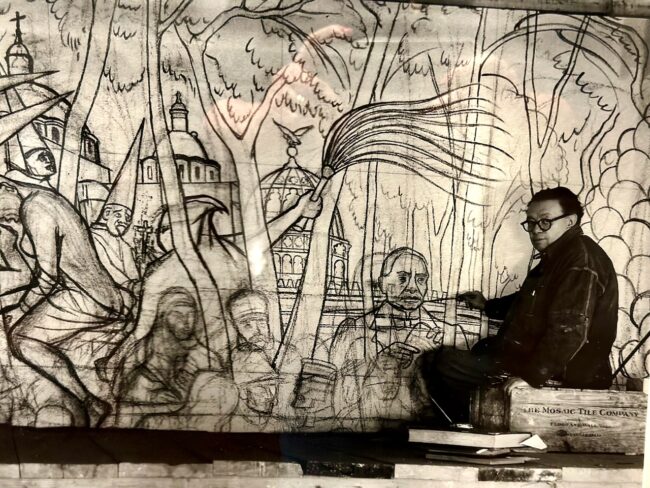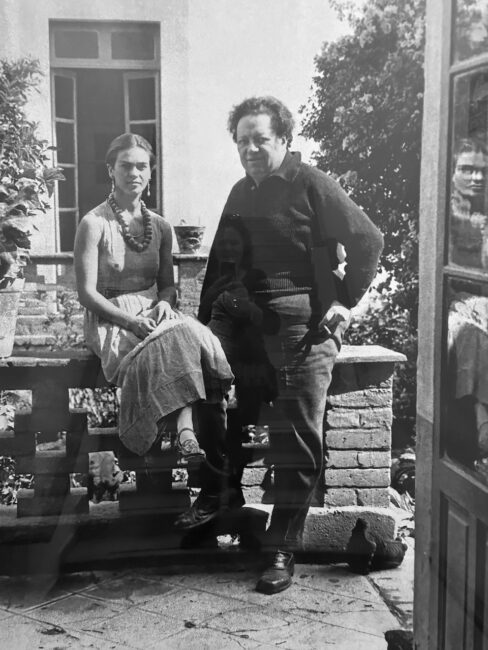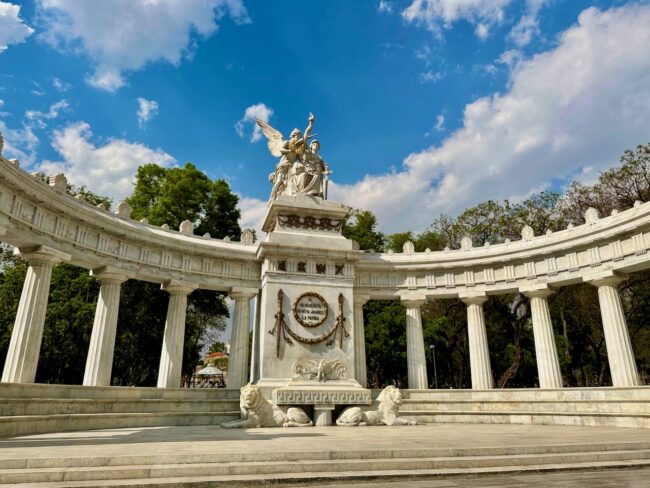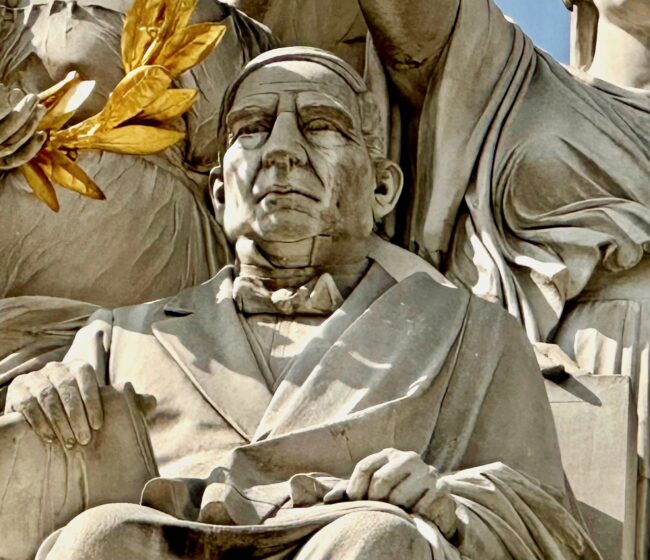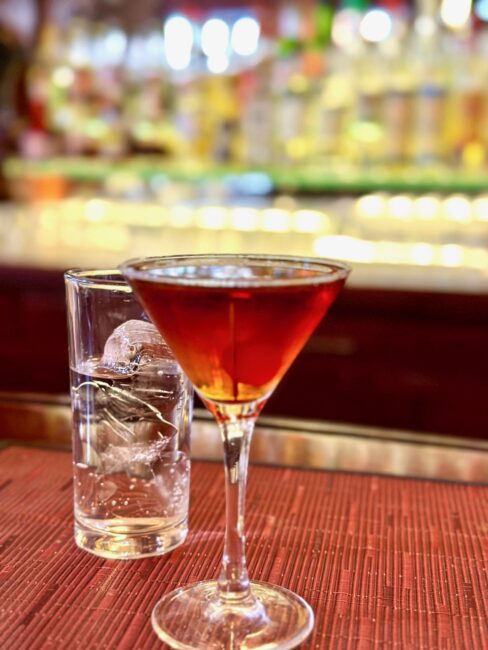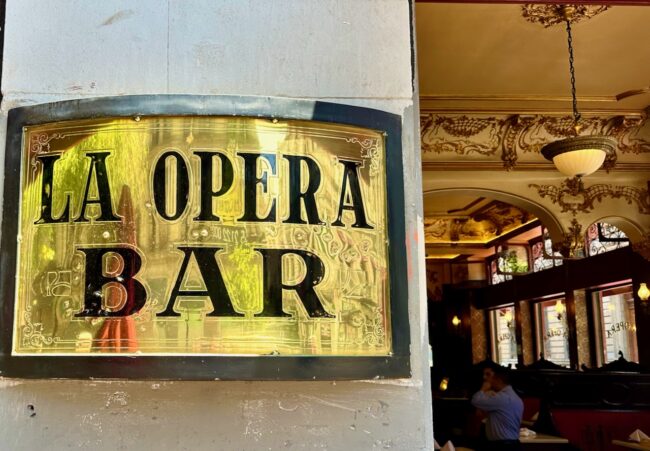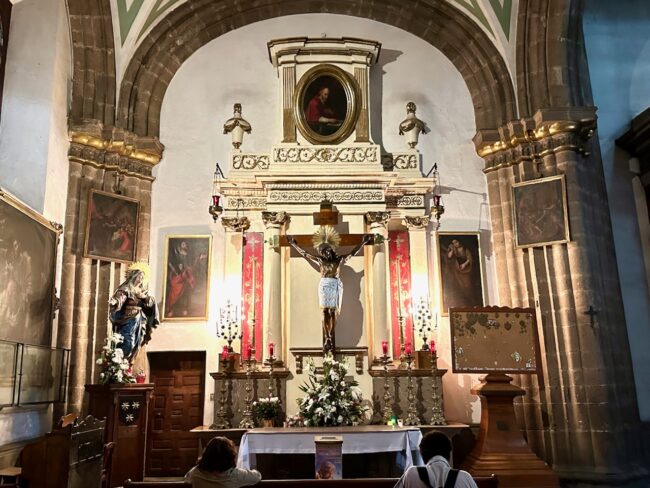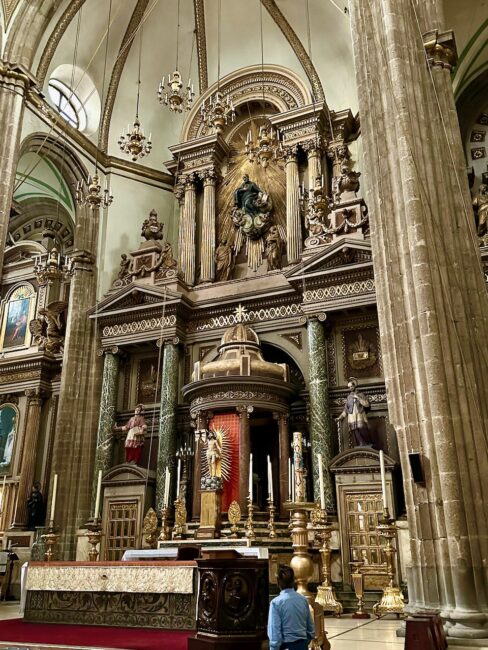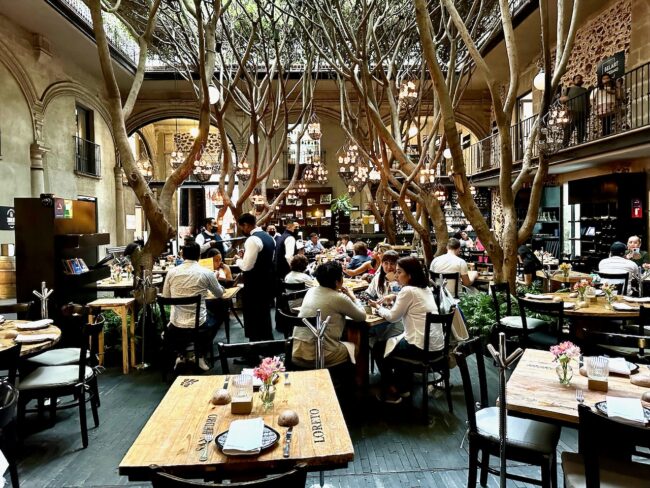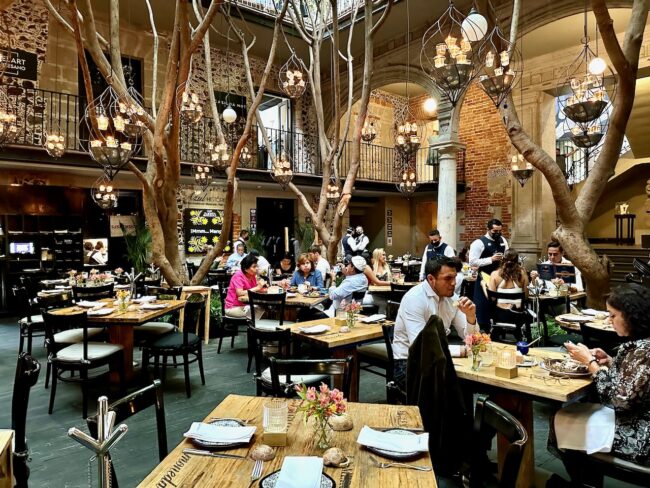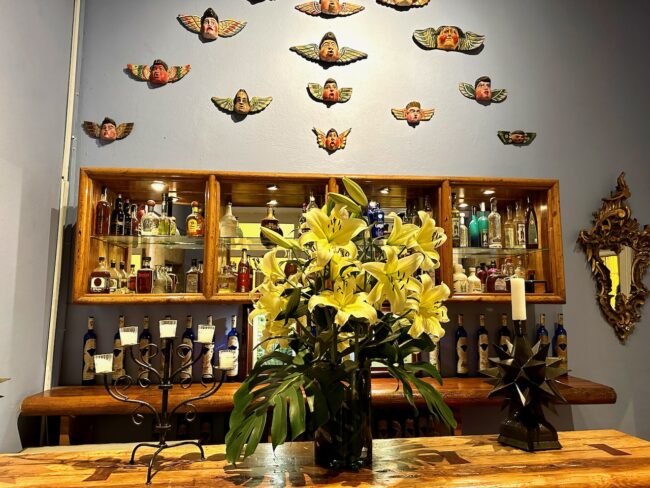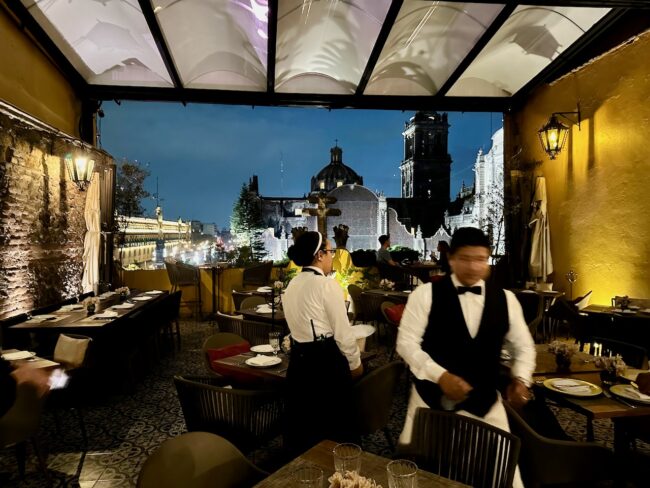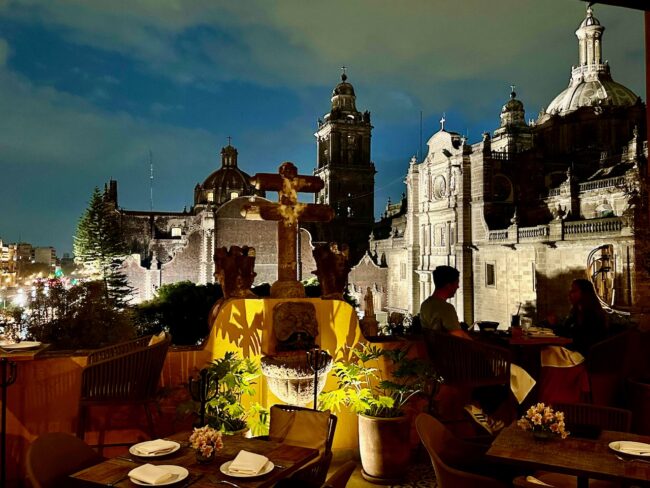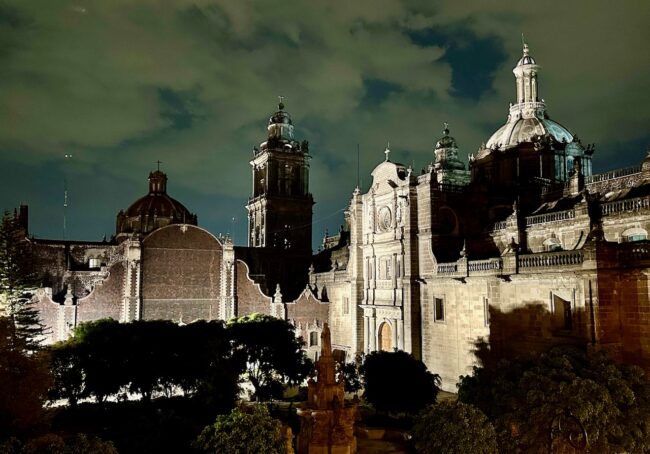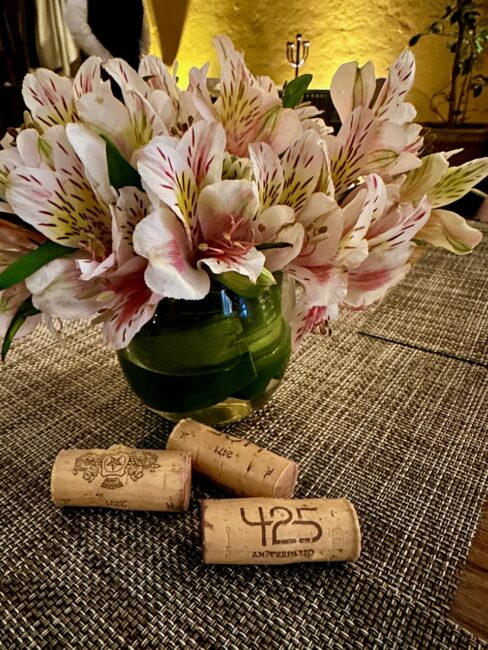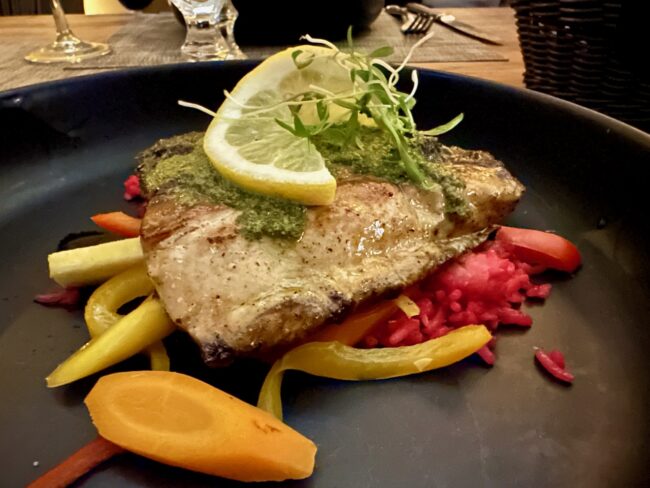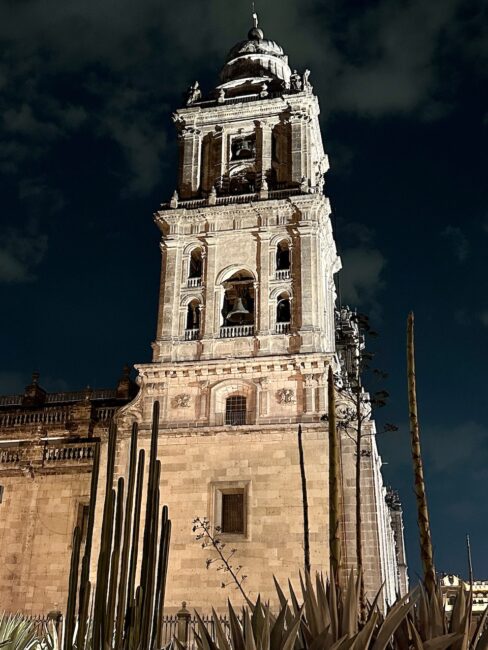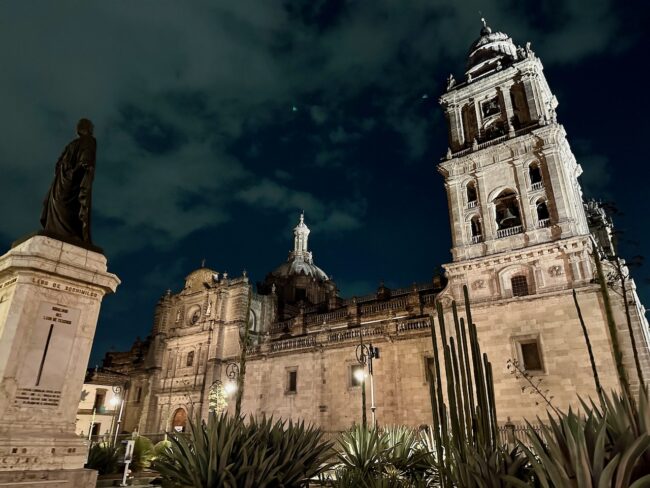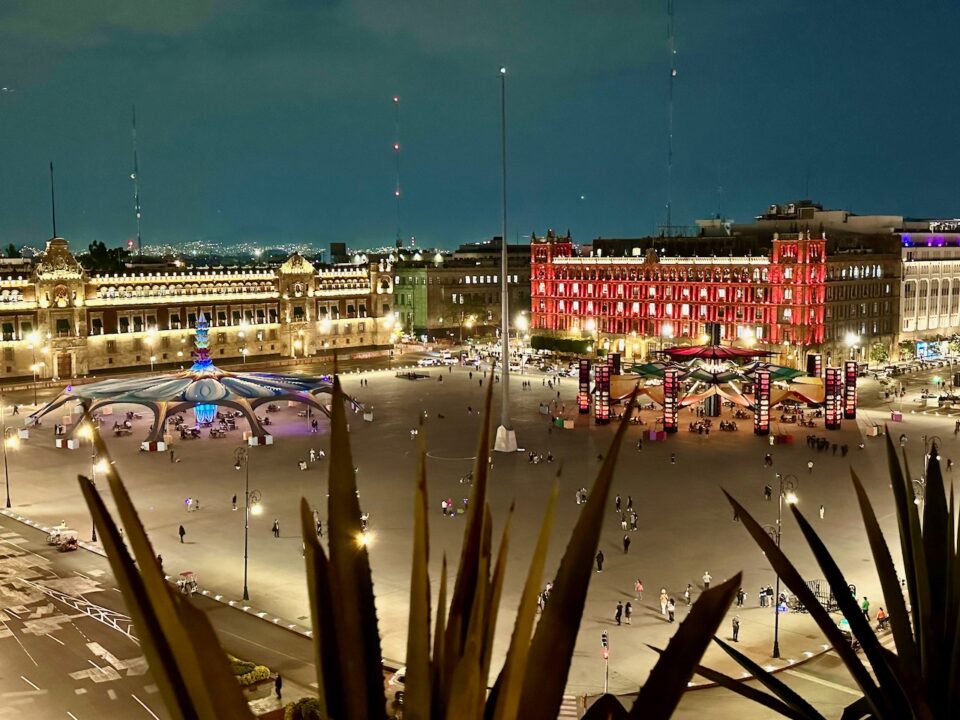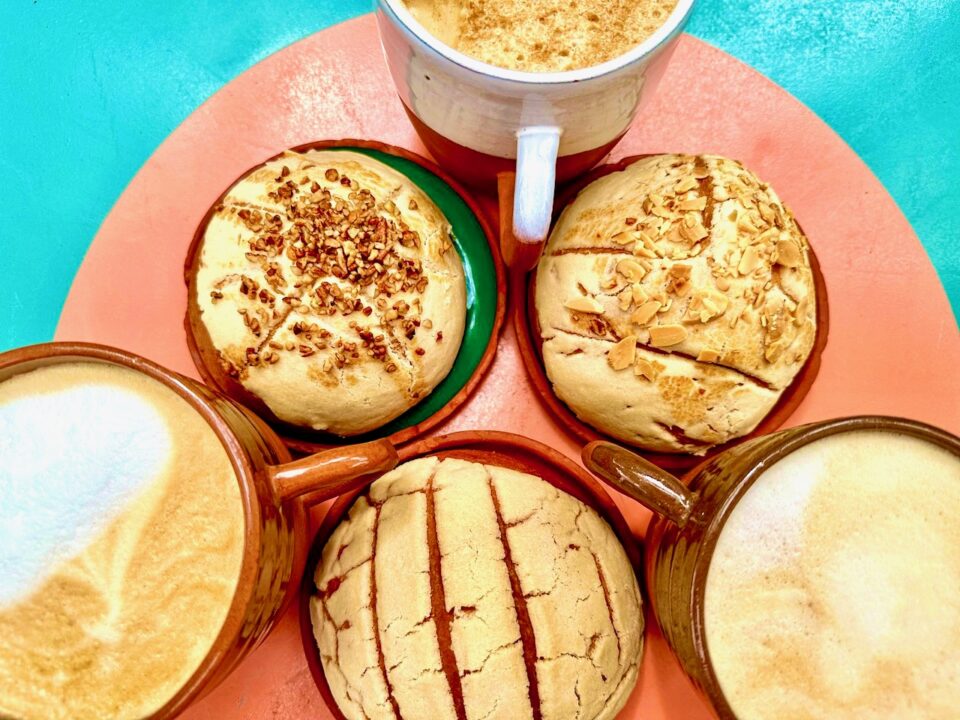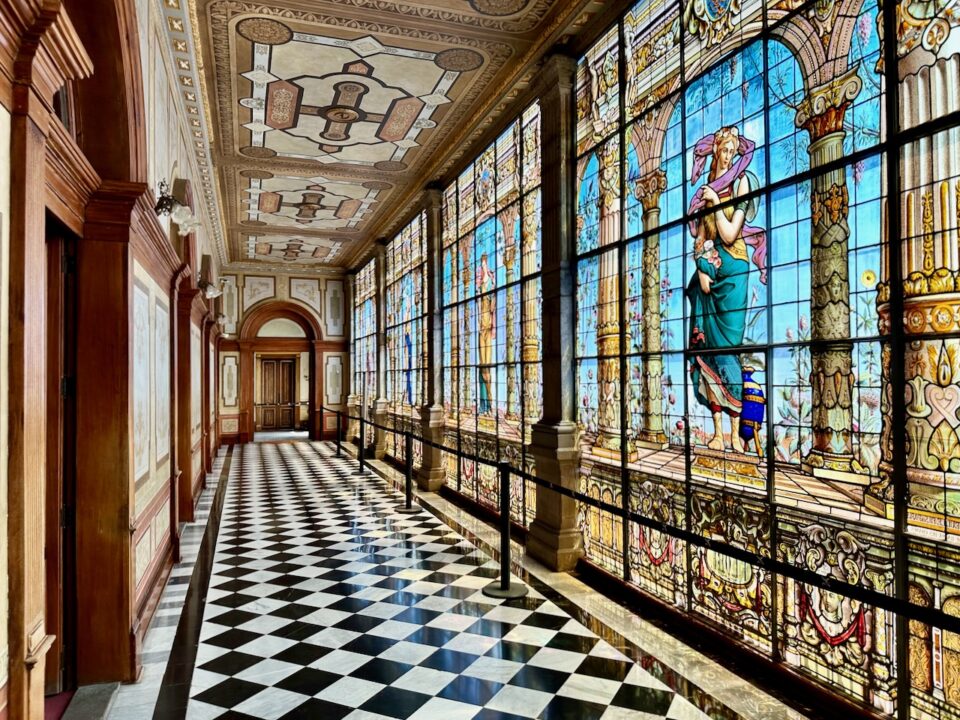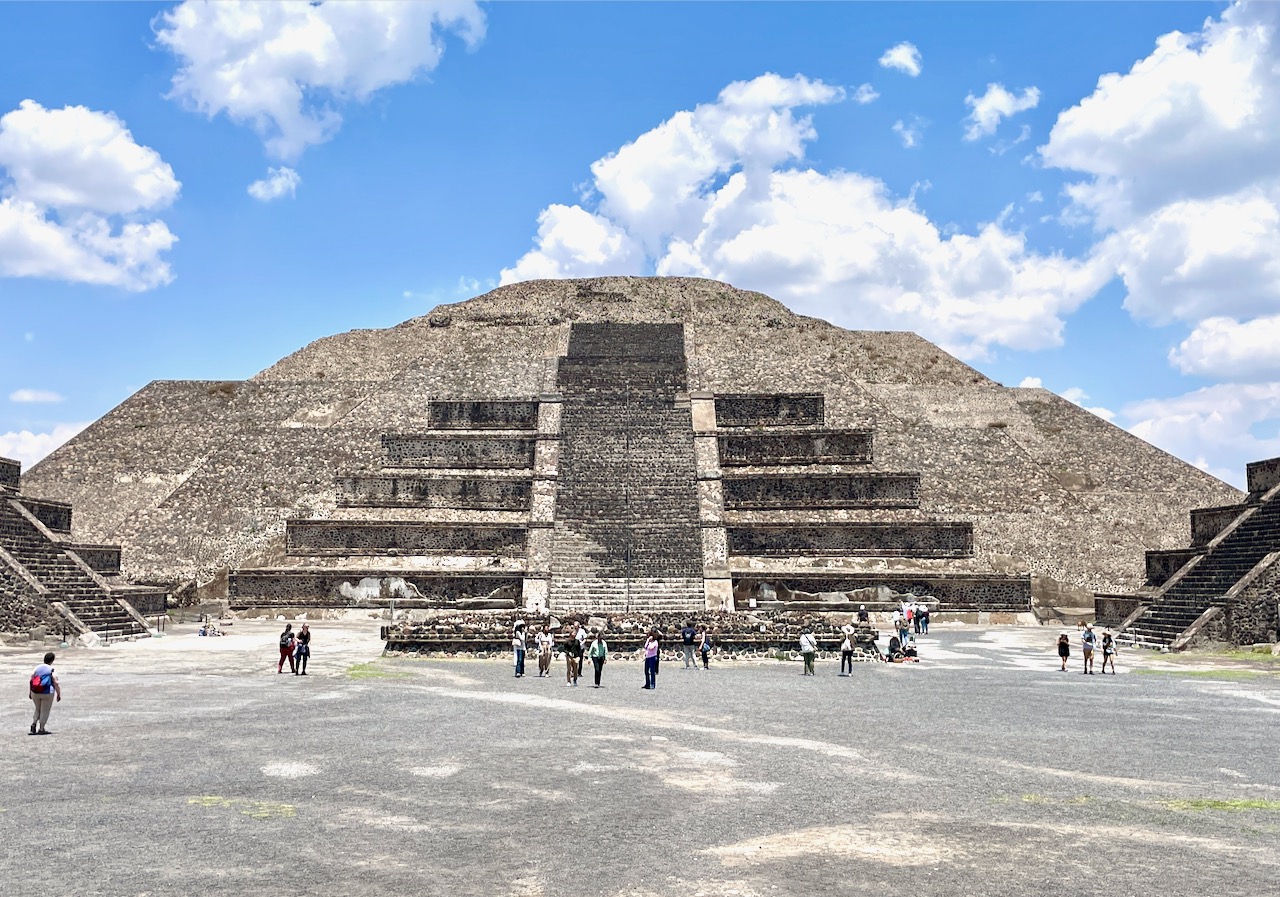
Chapter Four: Pyramid Scheme & The Miracle Cloak
June 10, 2023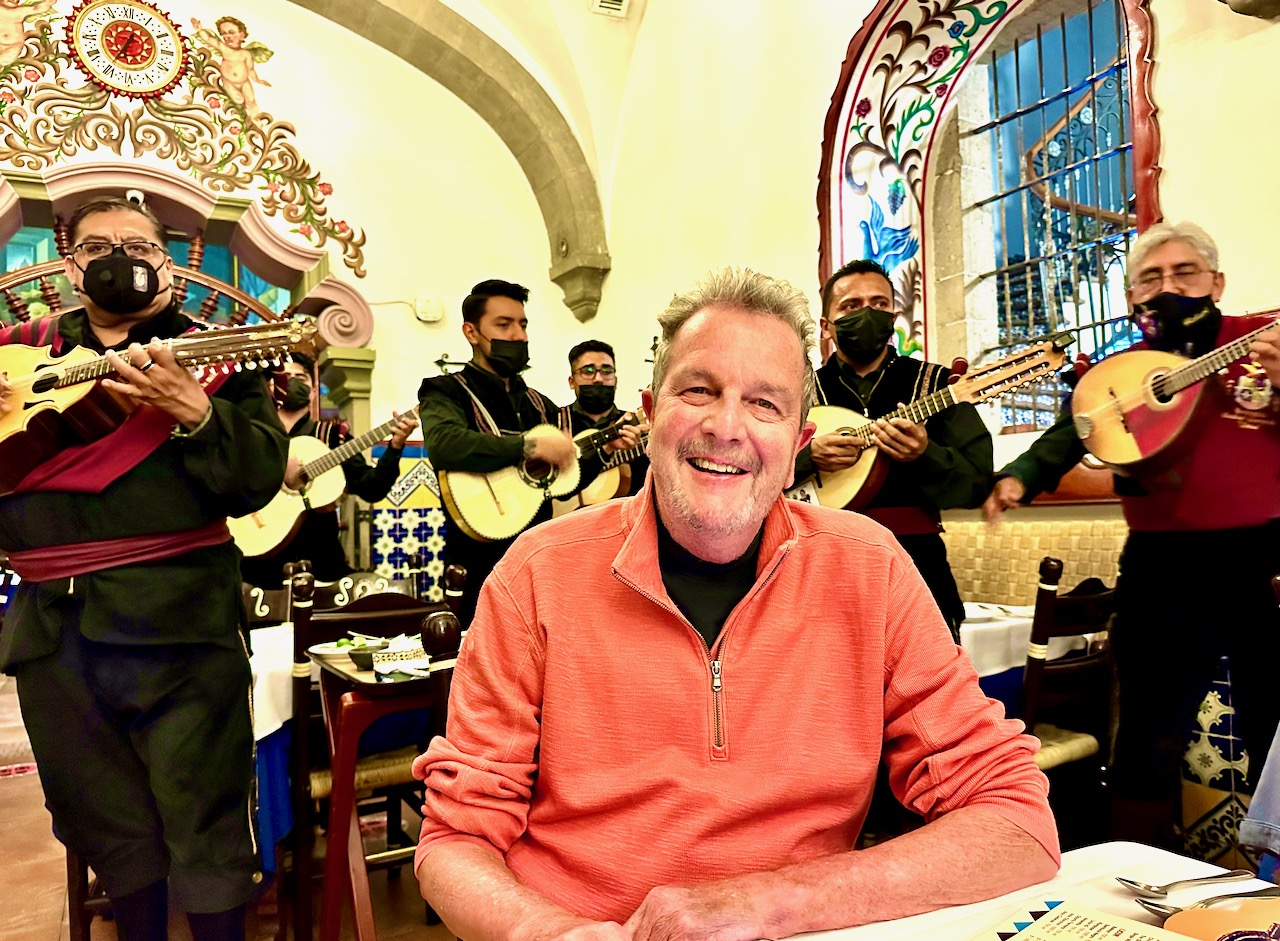
Chapter Six – “Russian” To See Coyoacán’s Museums & Music To My Ears
July 10, 2023Historical & Hip: Mai Tai Tomás Travels To México City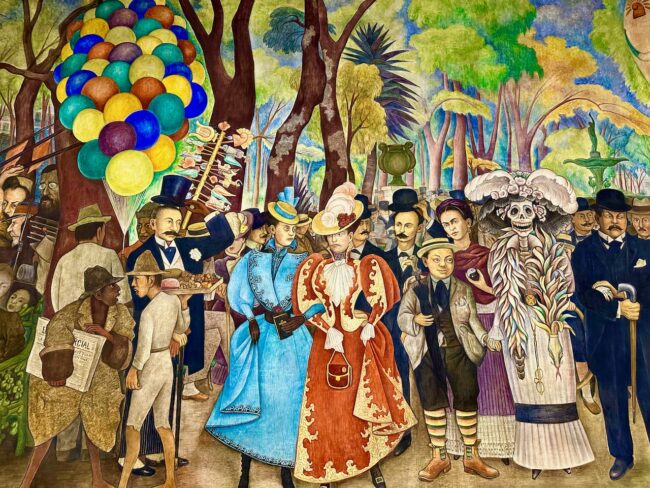
Chapter Five: Diego Rivera Mural Day
Day Five: Passports Please, No Dark Glasses, The History of Mexico In One Hour, Getting Rivera Public Education, Ruins At Lunch, What Piece Of Paper?, A Walk In The Park, Who Are These People?, Is That Mel Brooks?, Give Me A Shot and Our Last Rooftop Restaurant
Today would be our day to learn about the history of Mexico courtesy of Diego Rivera’s famous murals at the Palacio Nacional, which stretches across the east side of the Zócalo.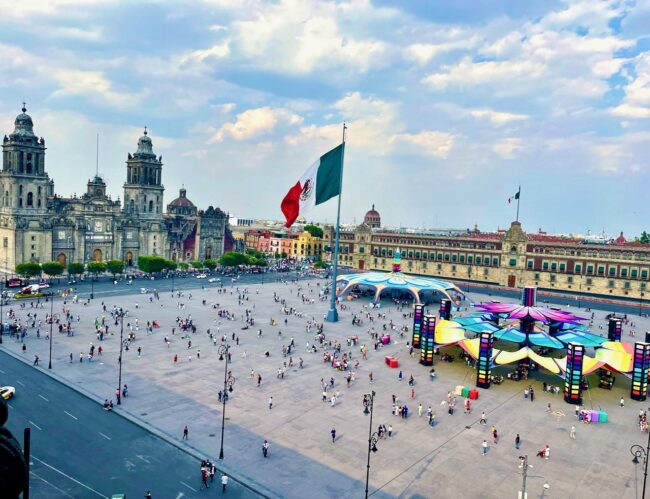
In an Estados Unidos lapse, I ducked into a nearby Starbucks and a Krispy Kreme for a quick breakfast. Don’t judge me, I was hungry and thirsty, and they were both open early. Tracy put a demerit on my world traveler card afterward. On the other hand, I was attempting to protect the environment.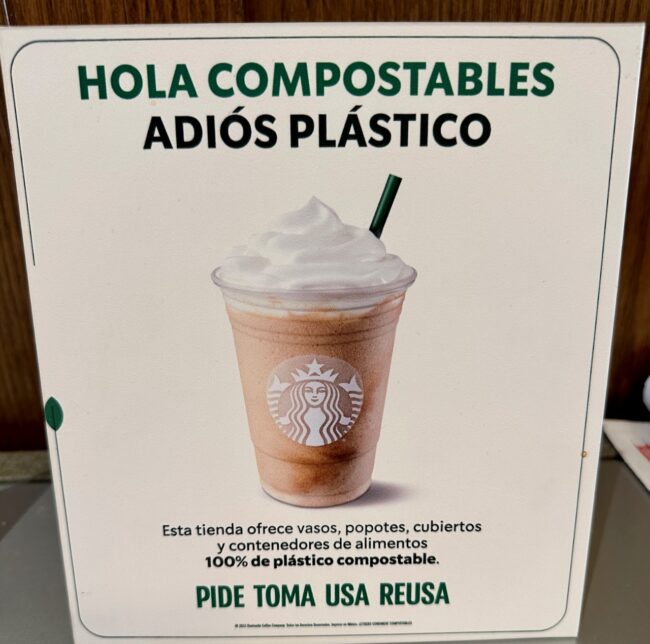
After our unhealthy breakfast, the three of us met up with Tim and Sheila. I had pre-booked (a must) a 10:30 free English-speaking tour of the Palacio Nacional (visitas_guiadas@hacienda.gob.mx). But first we had to cross the street to the Museum of Art of the Ministry of Finance and Public Credit to check in. Security throughout the process was very tight, and we had to hand over our passport or driver’s license, which would be returned after the tour. Among many rules was “do not wear sun glasses, but you can have them on your head.”
Our guide called out our names and asked us to form a line. Mine was the first name called, I assume because they wanted to keep an eye on me. At 10:30 we entered the grounds of Palacio Nacional, which originally began construction in 1522 on the site of an Aztec palace. It was intended to serve as the second home of Cortés, but I don’t think he ever lived here. It became the residence of the colonial viceroys and was called Palace of the Viceroy (or Royal House of the Viceroys). A lot of the palace was destroyed in a massive fire in 1692 and rebuilt over the course of many decades. After Mexican independence in 1821, it was renamed the Palacio Nacional and became the seat of the executive, legislative and judicial powers. Since 2018 the palace has been the official residence for the President of Mexico.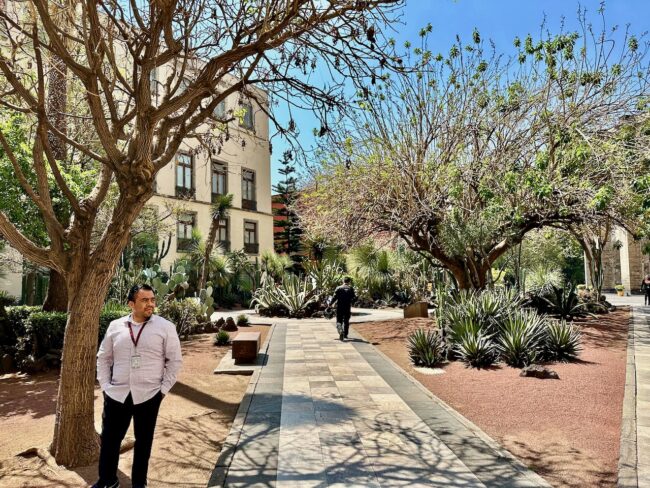
The group walked through an interior courtyard (one of 14) and into a cactus garden. We were accompanied by armed guards throughout the tour, so I decided to be on my best behavior. Lots of gardens dot the palace grounds (many not accessible to tourists), and this one contains plants that are indigenous to the Mexican desert.
Near the cactus garden stands the Capilla de la Emperatriz (Royal Chapel).
Entering the main courtyard we were told we could take photos of the fountain topped by Pegasus, however we could not take any photos toward the south of the courtyard. We surmised that was the direction toward the president’s quarters, and with armed guards 15 feet away I didn’t even dare to look that direction.
Palacio Nacional’s claim to fame are the second floor murals of Diego Rivera.
The first one we would focus on is painted in a staircase, and it is a marvel. You used to be able to ascend that staircase, but we were led to another one and headed toward the famous mural.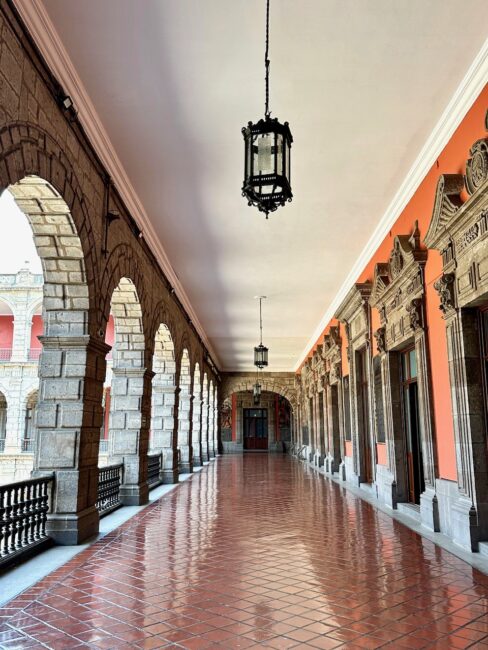
Rivera’s The History of Mexico is something to behold. It was here our tour guide stopped as she explained every detail of it.(remember. if you click on the photo it will enlarge and you can see more detail)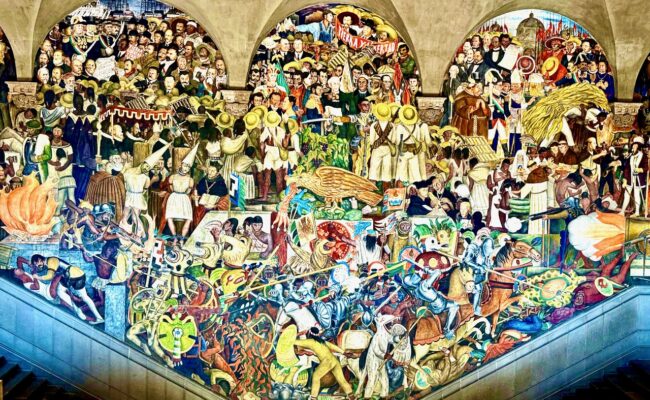
The three-section mural was designed to depict a different era of Mexican history. There’s really no way to show the entire mural, so we start with the mural on the right (north) side of the stairwell. Our guide said this section focuses on the ancient Aztecs, hence its name The Aztec World. Coincidentally Stephen, Tim and I have often been described as ancient Aztecs. You’ve got everything in this mural from the volcano blowing to a pyramid to Quetzalcoatal (Aztec version of a feathered serpent God) taking off in the top right. The rest of the mural depicts Aztec life and their class and warfare struggles.
Our guide led us through at least a 20-minute description of the center mural entitled From the Conquest to 1930. There is everything from the Spanish Conquest by Cortés to French rule and Emperor Maximillian to the US Invasion in the War of 1847.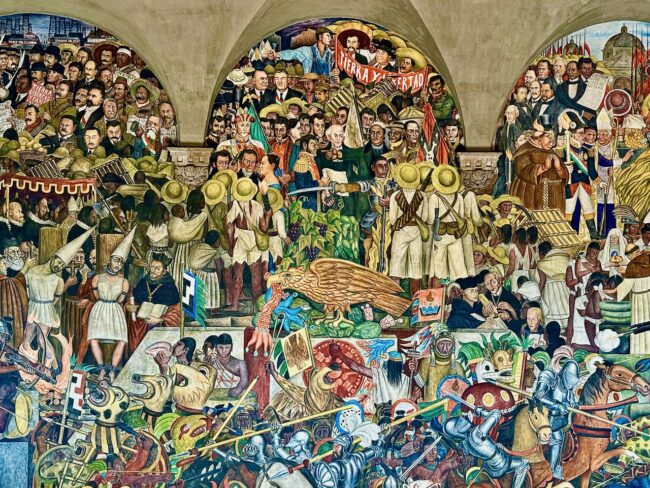
She shared that the eagle at the center reflects the center of the Mexican flag and gave us many tidbits more about this panel and pointed out historical figures with a laser. As our friend Mr. Spock would say, “Fascinating.”
The panel on the left is entitled Mexico Today and Tomorrow, which was painted some years later in 1935. Rivera’s wife Frida Kahlo is shown behind the woman in red below. Kahlo is wearing a hammer and sickle pendant. Capitalists like John D. Rockefeller are shown and anticapitalists such as Karl Marx are conveyed as “pointing workers towards a vision of a future industrialized and socialized land of peace and plenty.”
The entire mural and the history our tour guide weaved made this one of the most impressive tours I’ve ever been on, and as informative as the tour had been up to now, there were still a few more Rivera murals for us to view before departing.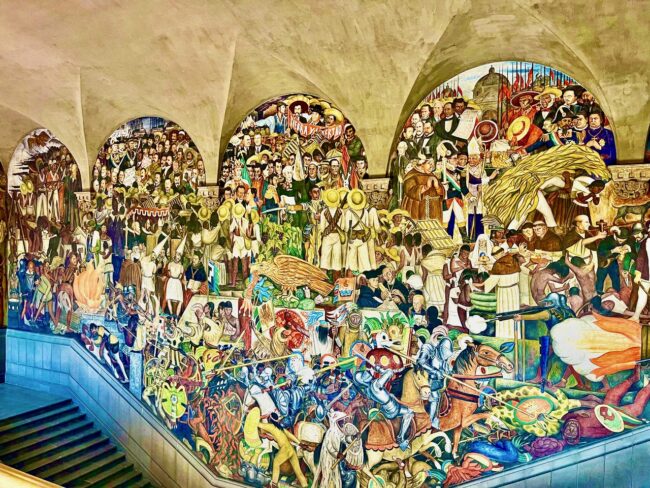
Painters and dyers shows people preparing pigments and dyeing fabric.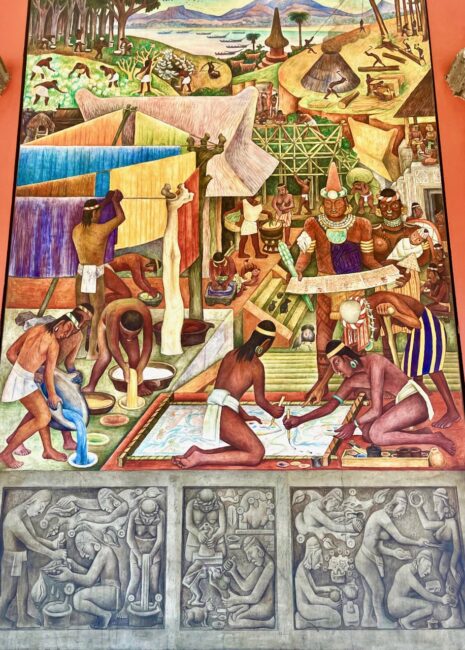
The main food of Mesoamerican was corn, so Maize demonstrates the various methods of preparing it.
Featherwork art and gold smith was followed by Festivals and Ceremonies.
Finally we looked at The arrival of Hernán Cortéz in Veracruz. Submission and destruction were depicted in this mural.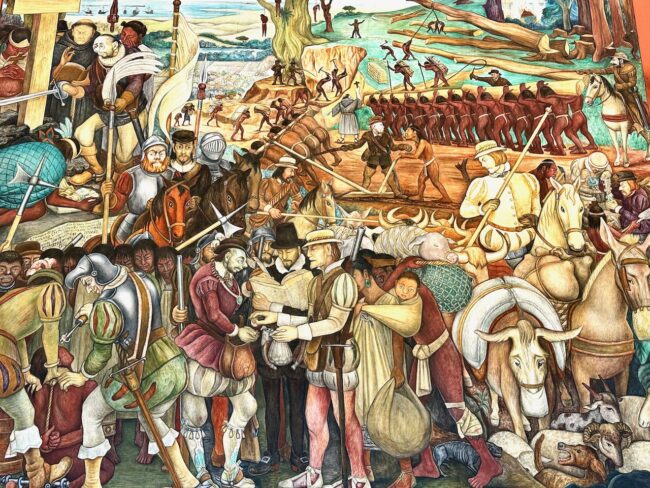
Rivera began his Palacio Nacional mural project in 1929.
The last one he painted here was in 1951.
It was his intention to cover the second floor with them, but he ran out of time.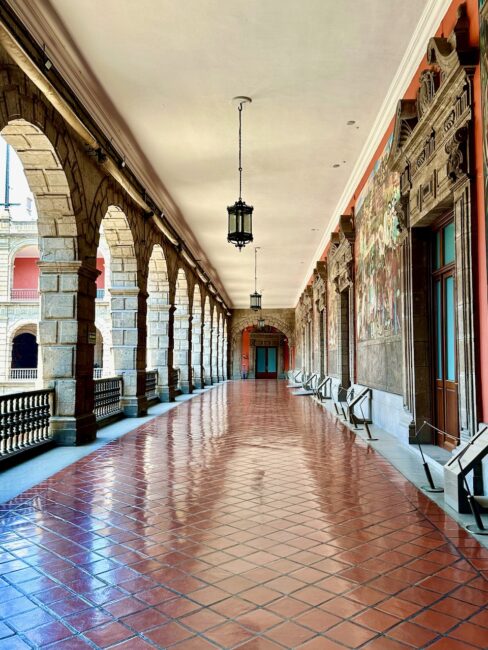
We then entered into the parliamentary chamber, which at one time was the seat of government.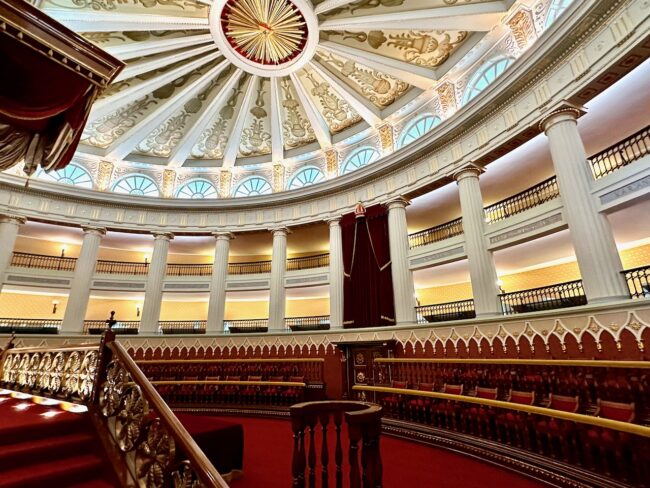
Even here, Tracy eyed another ceiling photo.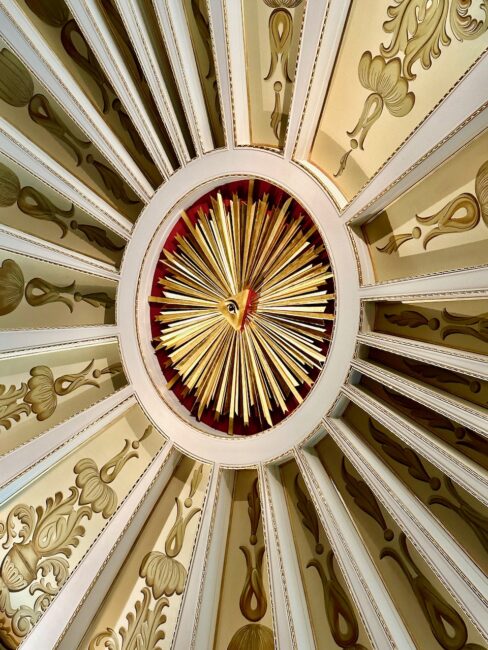
Outside the chamber is a gallery of paintings.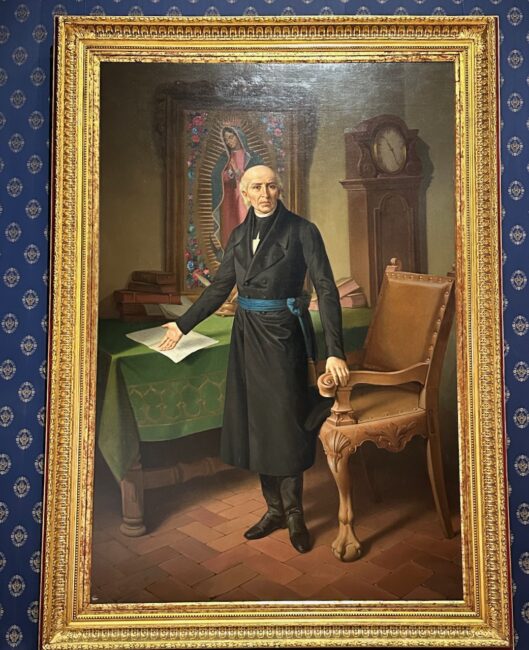
They included the Allegory of the Constitution, the Allegory of the Homeland and the 19th-century Allegory of Peace, Justice and Law.
We thanked our fantastic guide, retrieved our passports and we were on our way on another beautiful Mexico City day.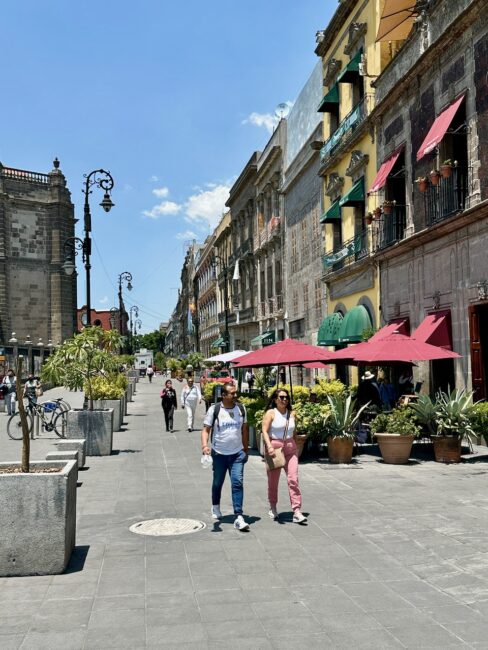
Passing by Templo Mayor, I reassured Tracy that we wouldn’t be seeing any more ruins. Well, at least for a couple of days.
Passing by these jolly characters we made our way to the nearby Secretaría de Educación Pública.
It is here where Rivera painted a series of fresco panels in its courtyard in the 1920s highlighting life of the people.
It’s free to enter, but you must have a valid ID.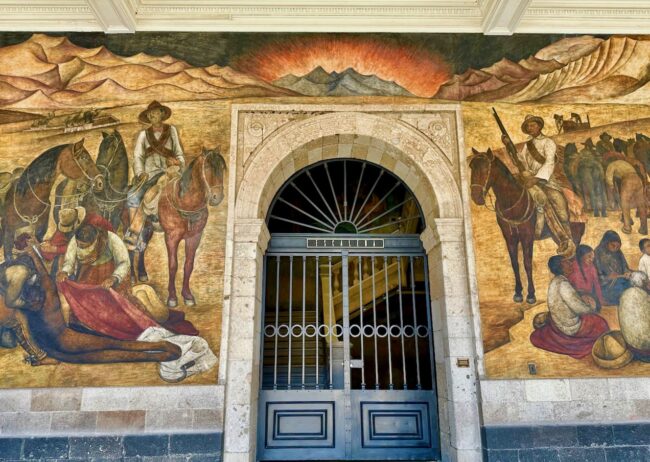
We toured the courtyard and its murals, many depicting agriculture, labor and industry.
Here were some people raising cane.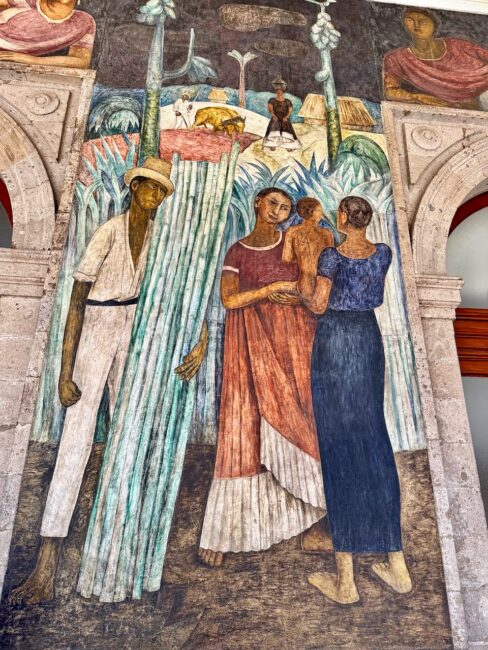
I was perplexed that this mural entitled Santa Anita did not include any horses.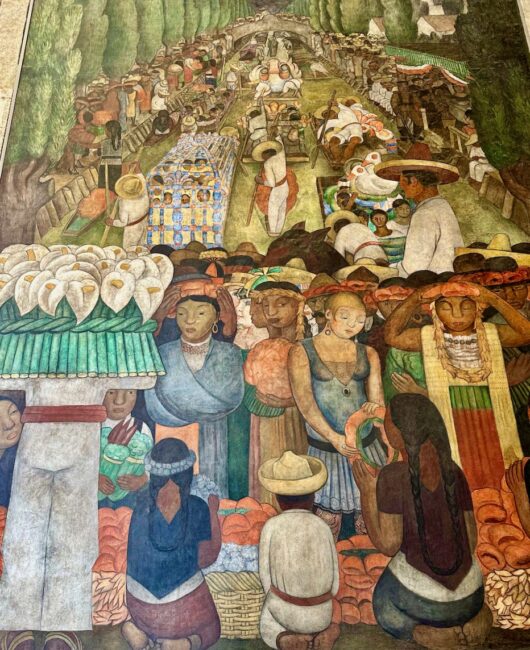
After touring the bottom floor, we realized we needed a “mural break” and since we all had pretty much decided this would not be our last trip to Mexico City, we could see the second floor murals on another visit. As it neared 1 pm, it was time to look for lunch, forgetting that is not primetime lunch hour in Mexico City Sheila recalled seeing a restaurant called El Mayor, which overlooked the ruins. We sauntered up to the restaurant about 15 minutes before 1 pm. The patio looked lovely, but it would not open for 15 minutes.
We decided to wait, and scored an excellent table, probably because we were the first ones there, overlooking Templo Mayor.
Outside of Tim’s tortilla soup, it was Tacofest Tuesday in CDMX.
Midway through lunch, Sheila casually asked if we thought that slip of paper we received after immigration stating that it was needed to be able to return to the United States was really necessary. Tracy’s reply had me a little worried … “What slip of paper?” I decided to have a drink.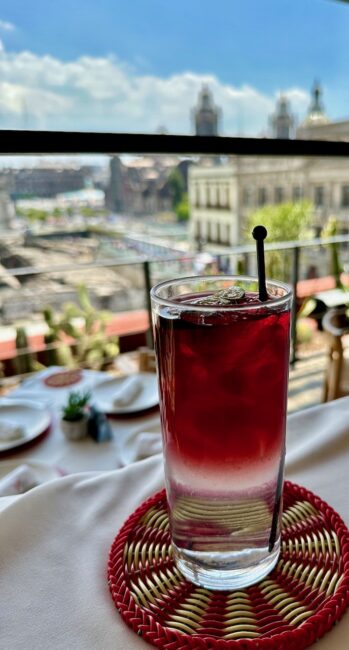
As much as we were loving Mexico City, we did need to get back at some point because we have a dog and cat that miss us, mostly at feeding time. Tracy frantically rifled through her purse. I have never known how you can store so much in those things. Yes, we had received the slip of paper and for some reason Tracy had not tossed it out yet. The pets were saved (although, truth be told, sometimes we think they like the pet sitter more than us).
After lunch we went our separate ways (but only for a short time). Tim and Sheila headed off to the Palacio de Bellas Artes, Tracy and I started toward Museo Mural Diego Rivera (can’t get away from that guy) while Stephen eschewed murals for a taste of hooch at the Museo del Tequila y el Mezcal. First, however, we had to stop for gelato.
One reason we felt safe throughout Mexico City was the police presence we witnessed throughout the city. Tim had said the same thing as he and Sheila had walked around different neighborhoods.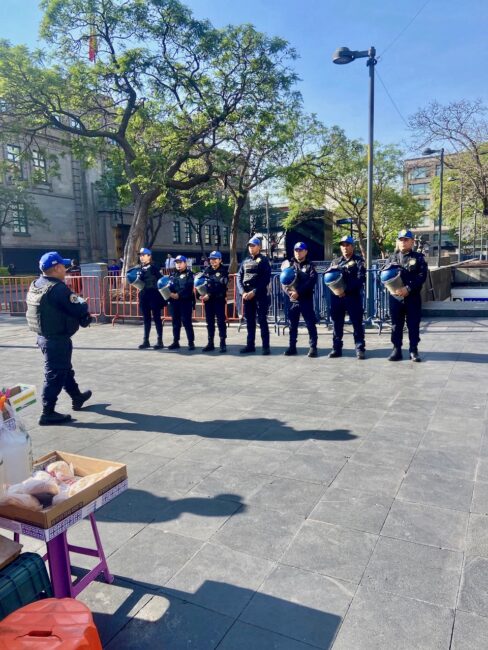
That was certainly the case as we approached Alameda Central, which has been an integral space since Aztec times when it served as a marketplace that hosted civic gatherings.
The park originated in 1592 with poplar trees abounding. Walking through the park, fountains, of which there are about a dozen, were the order of the day.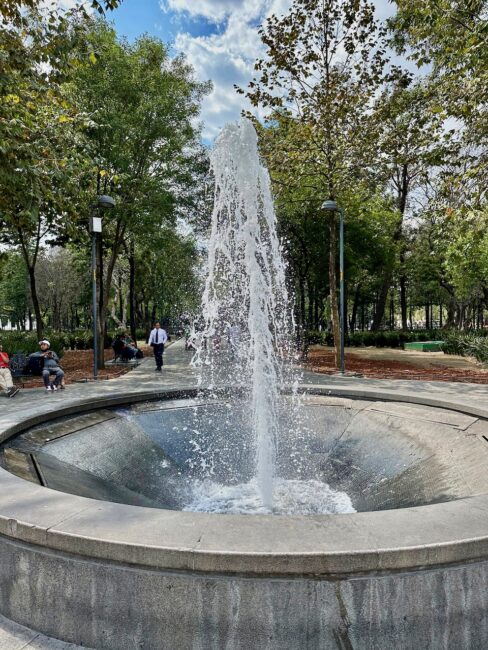
We passed by old Neptune who we have seen around the world, unless we see one that is called Poseidon. It’s all Greek to me.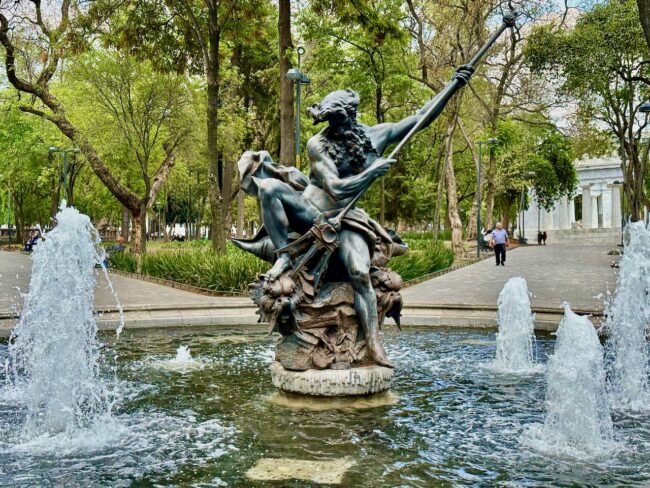
This fountain interested me, so I looked it up and learned that it is called Las Danaides, a fountain that “depicts two women representing the 50 daughters of Danaus,” who was a king of Libya. I’d hate to pay for all those weddings.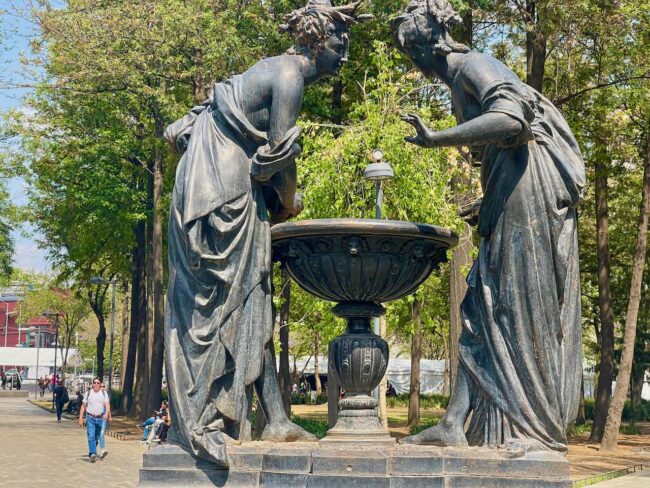
Children frolicked in the Fountain of Virgin, which is the central fountain of the park.
Nearby, we watched a person sitting on a bench make acquaintances with a furry friend. For just a moment, Tracy and I were really ambiancing.
The Museo Mural Diego Rivera is located adjacent to the park (across the street and down an alley). 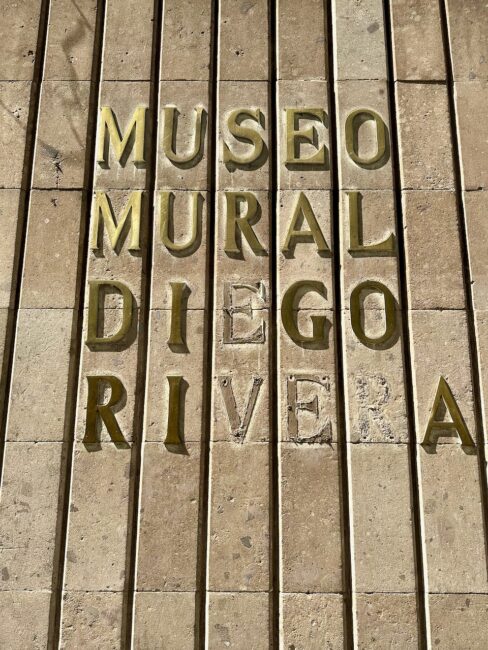
The star of the show is Rivera’s famed Dream of a Sunday Afternoon in the Alameda Central. The museum was constructed in 1986 to house the mural, one whose existence is truly a miracle.
The mural was originally painted on a wall of the Hotel del Prado in 1947. In 1985 an earthquake caused so much damage that the hotel had to be demolished. Somehow the mural escaped virtually unscathed. The 16 1/2-foot tall by nearly 50-foot wide mural that weighs nearly 35 tons was transported (carefully) 165 feet. The short journey took 12 hours and was accompanied by mariachi bands. The museum was actually built around the mural, and it’s free for seniors (60 and older). For the first time Tracy received a free senior admission. Although happy to enter free, she now was feeling old. Welcome to my world.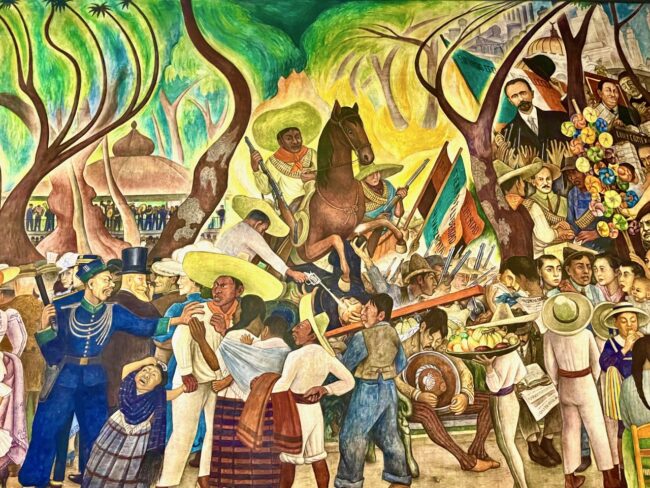
The mural is an overload of color and characters. More than 100 characters from Mexico City’s history are displayed. From left to right “it is a dream: everyone ponders the past the present and the future from the Spanish Conquest and the Holy Inquisition to the modern days of the first half of the 20th century.” Fortunately, there is an illustrated guide that helps identify the various characters. In the center stands the skeletal Catrina, shown to “critique the Mexican elite.” To her right is Catrina’s creator José Guadalupe Posada, who was said to have been a great influence on Rivera. She holds the hand of Rivera (who is depicted as a child)) and behind him is Frida Kahlo, who affectionately referred to Rivera as “The Toad.” For the rest of the story, book a trip to Mexico City..
This is the mural that helped “catapult the Catrina to Day of the Dead fame.” 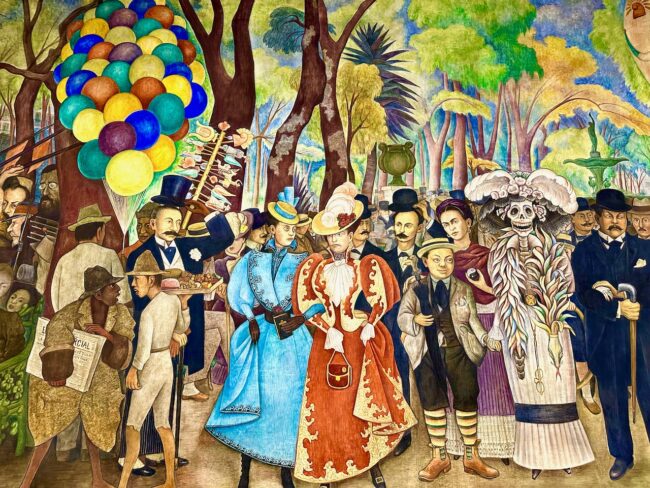
She is Mexico’s “grand lady of the afterlife,” and is the centerpiece of Día de los Muertos, the Mexican holiday that honors the lives of the deceased (we now celebrate this at the Casa de Mai Tai).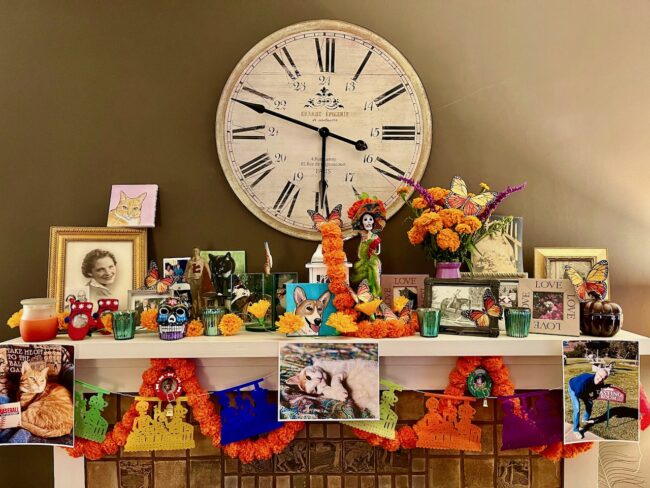
We walked upstairs to view the mural from a higher vantage point.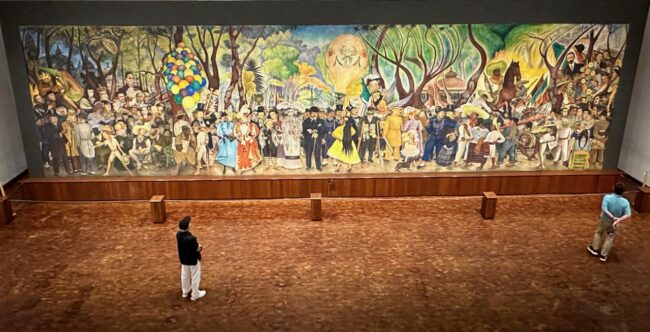
Outside of the mural, there are just a few other pieces of art …
… and photos.
Strolling back through Alameda Central Tracy saw a statue and asked, “Is that Mel Brooks?” From our angle he did look a little like the director of the greatest comedy of all time, Blazing Saddles.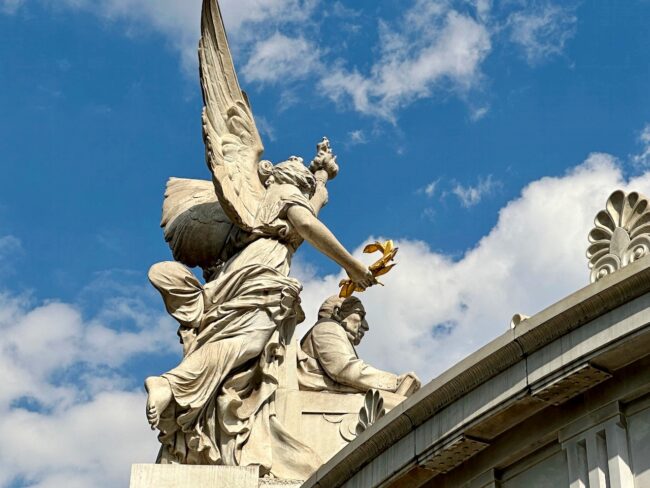
As we walked around the front, it wasn’t Mel and didn’t look like Mel. It was The Benito Juárez Hemicycle. The neoclassical memorial commemorates the man who was Mexico’s 26th president and the first indigenous president of Mexico.
Our next stop was the Bar La Opéra, a bar/restaurant where revolutionary general Pancho Villa supposedly shot a hole in the ceiling. Hey, any excuse for a Manhattan.
And on your upper right, there’s Pancho’s bullet hole in the ceiling. I guess that’s one way to get a shot at a bar.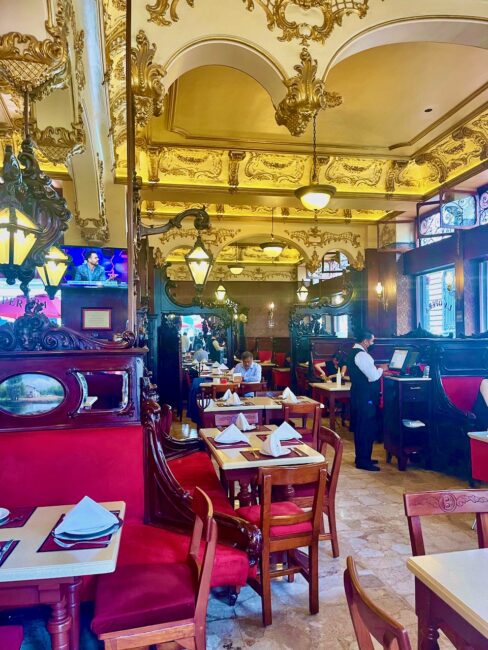
We asked Stephen, who had joined us along with Tim and Sheila, how he liked the Museo del Tequila y el Mezcal. He said it took him about an hour to go through the exhibits, and he also said the discussion of the origins of the mariachi was interesting. He walked to the nearby Plaza Garibaldi, which on weekends hosts lots of mariachi bands. On this Tuesday, it was virtually empty.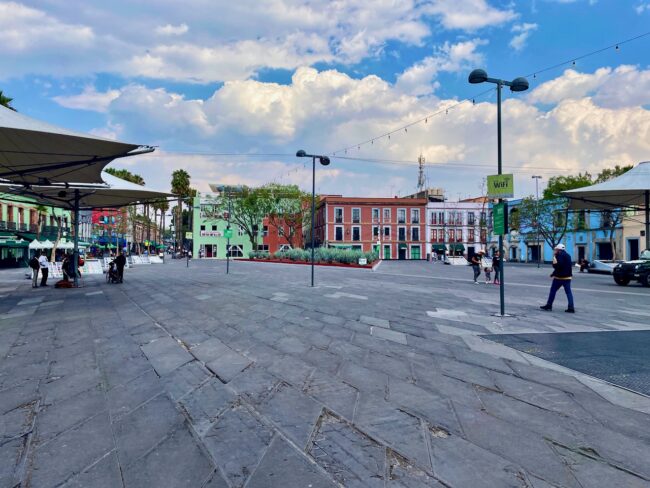
Outside the bar we saw a Volkswagen that looked like it was being compressed by Tracy’s finger.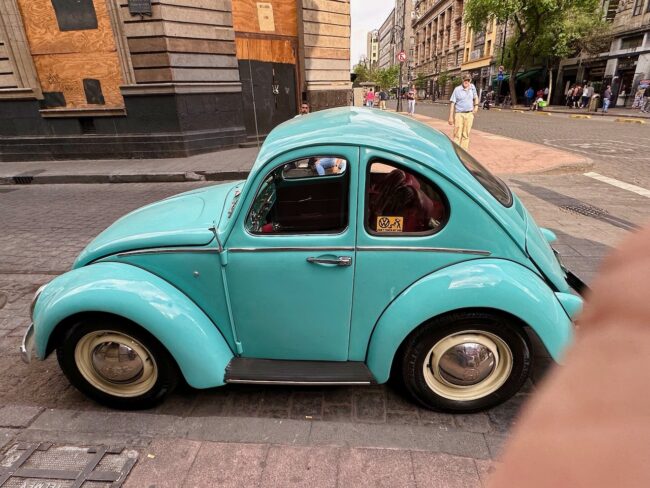
On the way back to the hotel, we ducked in a church that I think was Iglesia La Profesa, but due to the Manhattan I can’t be sure.
We passed by Casino Español, a restaurant I had highly considered as a dinner spot and will probably go to on our next Mexico City adventure.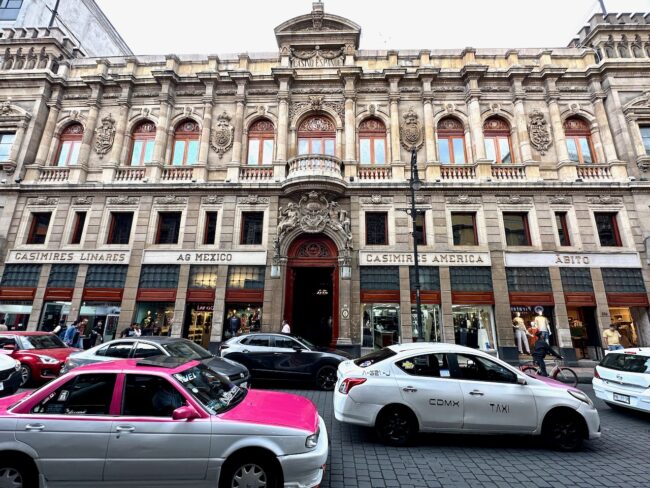
Tracy wanted to stop back into Azul Historíco to visit its gift shop, because Tracy had seen some things she might want to purchase. Our wallets were saved by it being closed, but we once again admired the space.
I have no idea how many tortillas she makes in a day.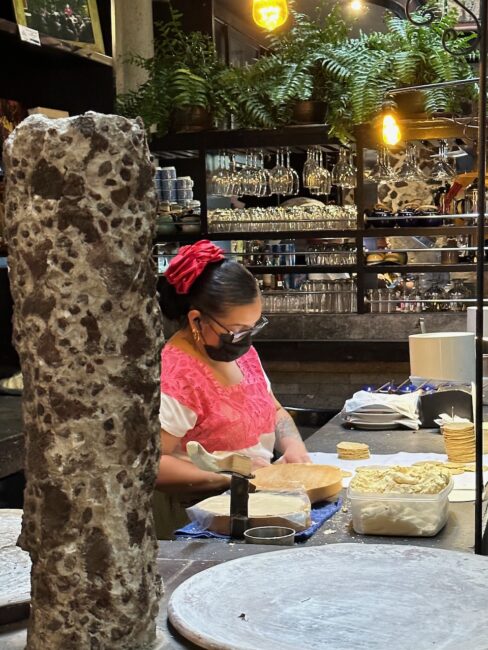
Speaking of restaurants, we all met for dinner at La Casa de las Sirenus, where once again we would dine on the terrace.
Our dinner views were terrific.
We started with Guacamole with Fried Pork Rinds; guacamole with serrano chilies, coriander, onion and Farmer’s cheese.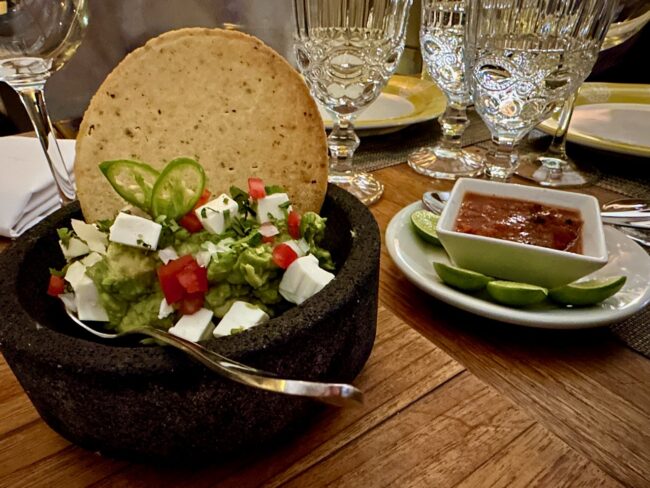
Dinner was good and the wine was flowing, which might be why we couldn’t find our notes on what we had for dinner.
I think this was a cheesecake. I do know I ate most of it and it was delectable.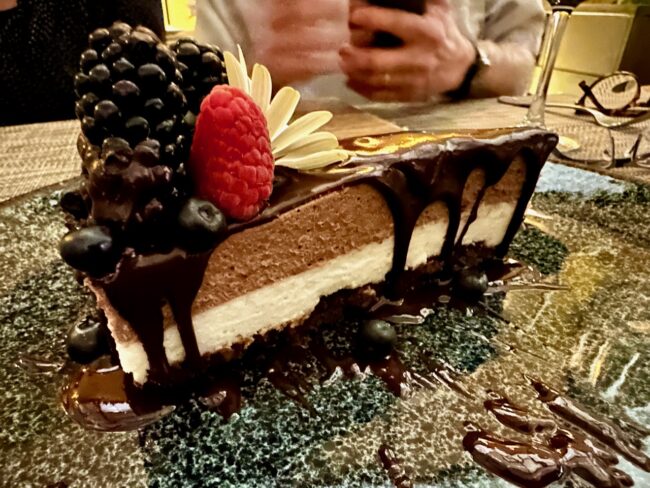
We admired the views one last time …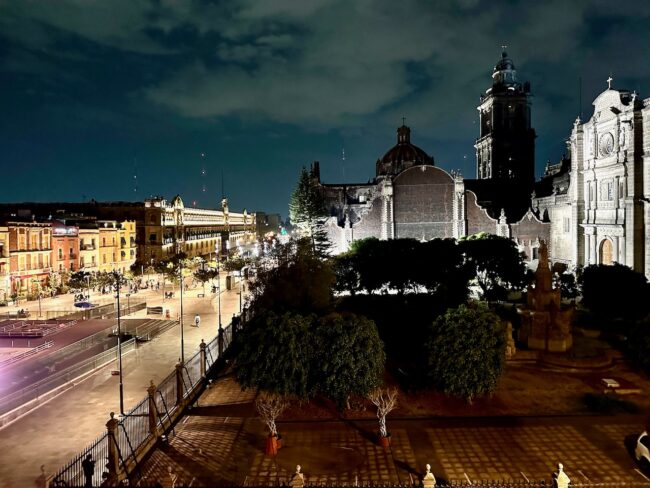
… and took a lovely evening stroll back to the hotel.
When we got in our room we learned that there would be a citywide earthquake alert the following day at 11 a.m. Coincidentally, at about 2 a.m. Tracy and Stephen (not sleeping together) were awakened by … an earthquake, so the alarm would sound about nine hours too late. By the way, I did not wake up during the quake. That’s what happens when you grow up in Southern California.
The majority of the following day would be spent in Coyoacán. We’d start by exploring the museum in the house where a Russian revolutionary was assassinated and then follow that up with a tour of the home of a woman, who’s tough life was almost as famous as her art. We’d check out the nearby market and one of the oldest surviving houses of worship in Mexico City. Then we would all Uber another half hour to a Coyoacán restaurant owned by relatives of our friends in Southern California. It was here that I learned I loved seafood, and even more importantly, discovered a drink I have been trying to replicate since I arrived home home.
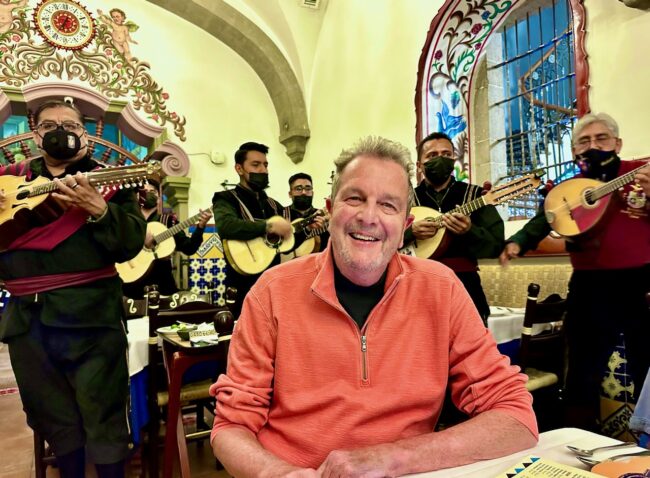 Back in Centro Histórico we would see the rest of the Metropolitan cathedral, where once again I would make an absolute fool of myself. We’d end the evening at a historic restaurant complete with mariachis, where our light meal turned out to be not to be so “light.”
Back in Centro Histórico we would see the rest of the Metropolitan cathedral, where once again I would make an absolute fool of myself. We’d end the evening at a historic restaurant complete with mariachis, where our light meal turned out to be not to be so “light.”
Chapter Six – Russian To Coyoacán’s Museums & Music To My Ears
Day Six – Hot To Trotsky, Axe To Grind, It’s Only A Drill, Feeling Blue With Frida, Strolling Through The Mercado, Where’s The Entrance?, Seafood Heaven, The Magical Mango Margarita, I Can’t “Handle” This, Even St. Michael Was Embarrassed and Enjoying Dinner (Plus Music) at One Of Mexico City’s Oldest Restaurants

